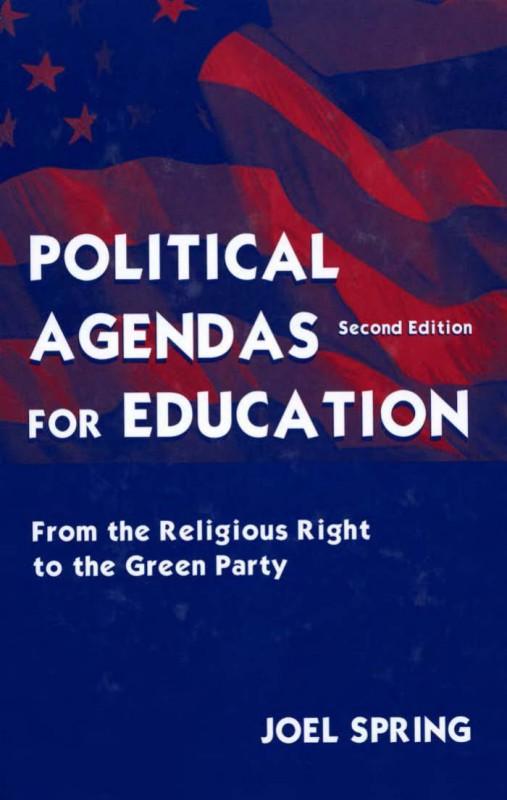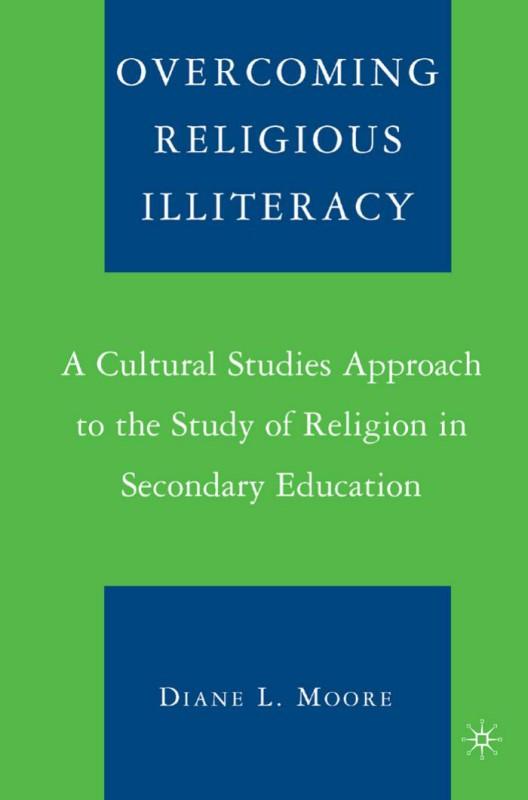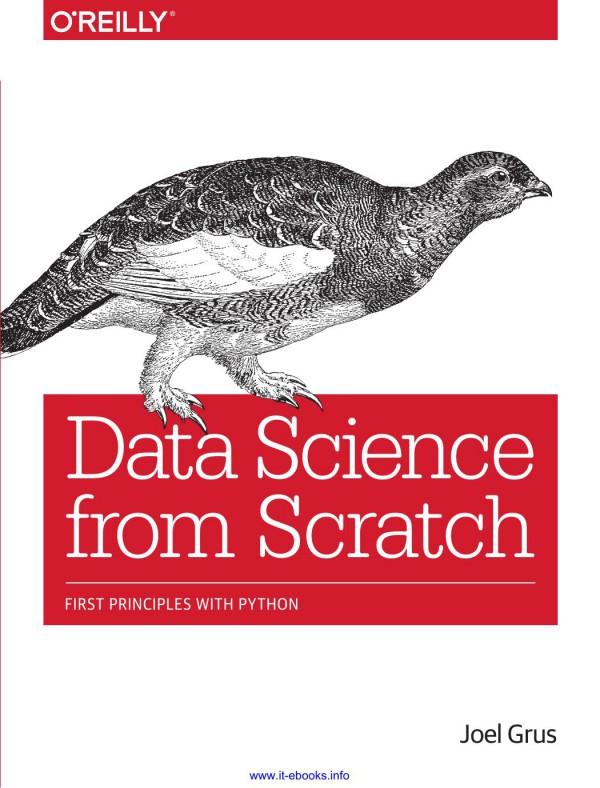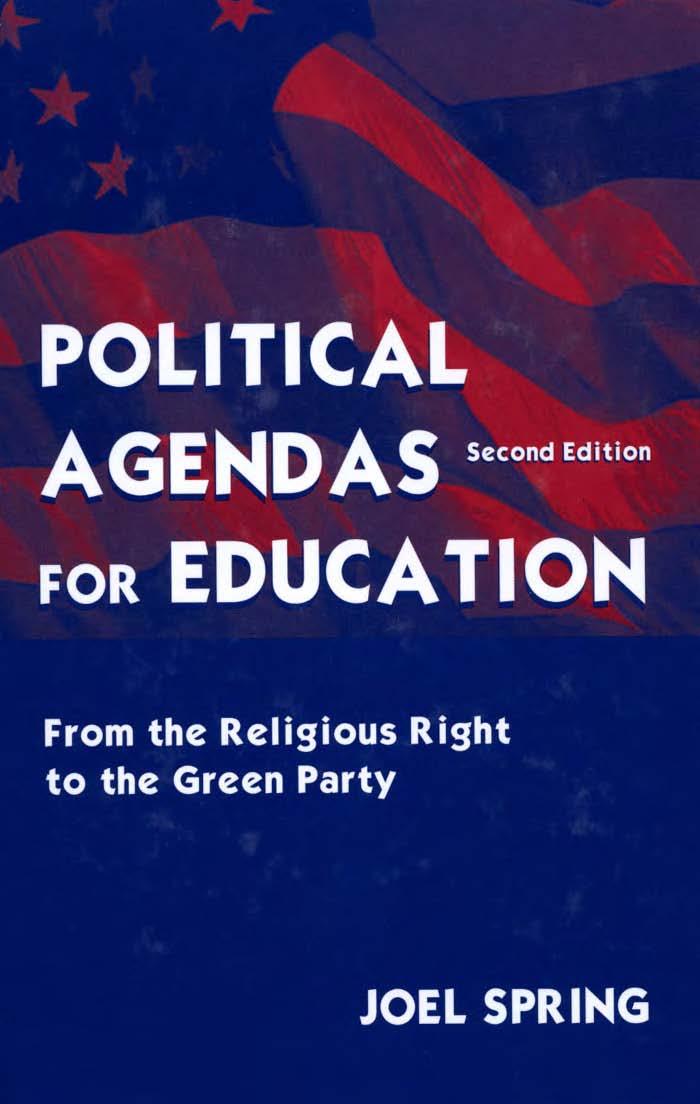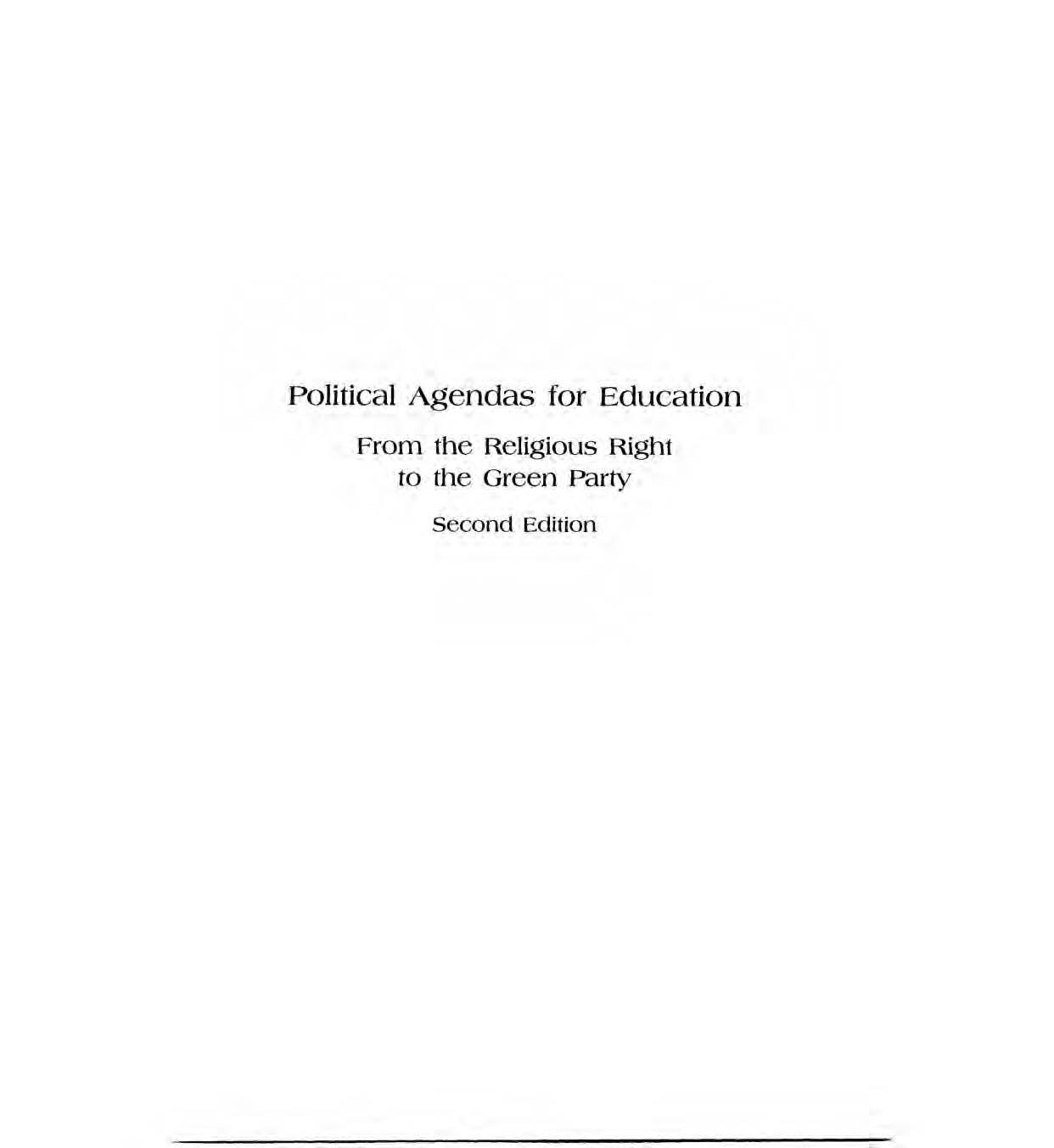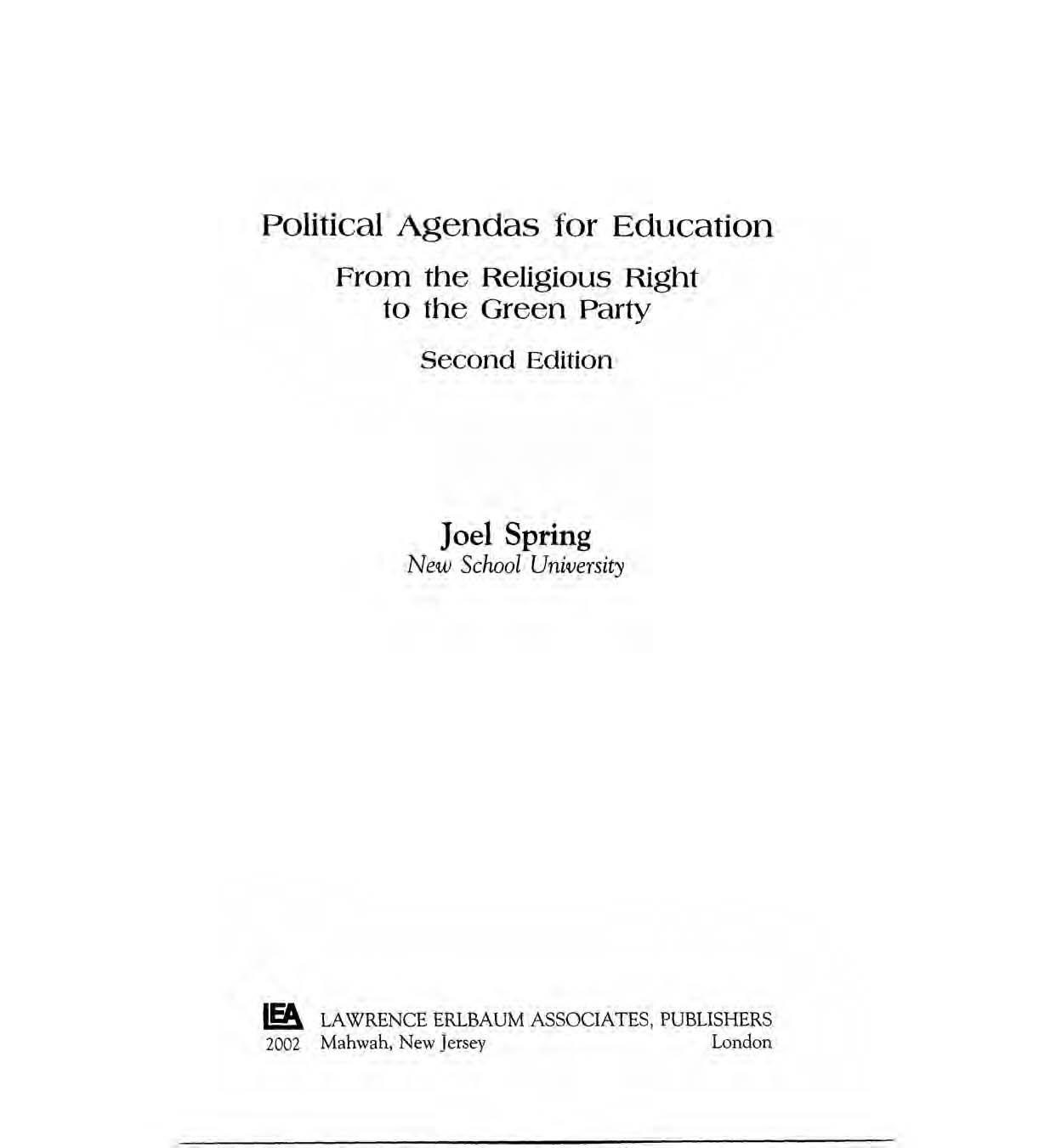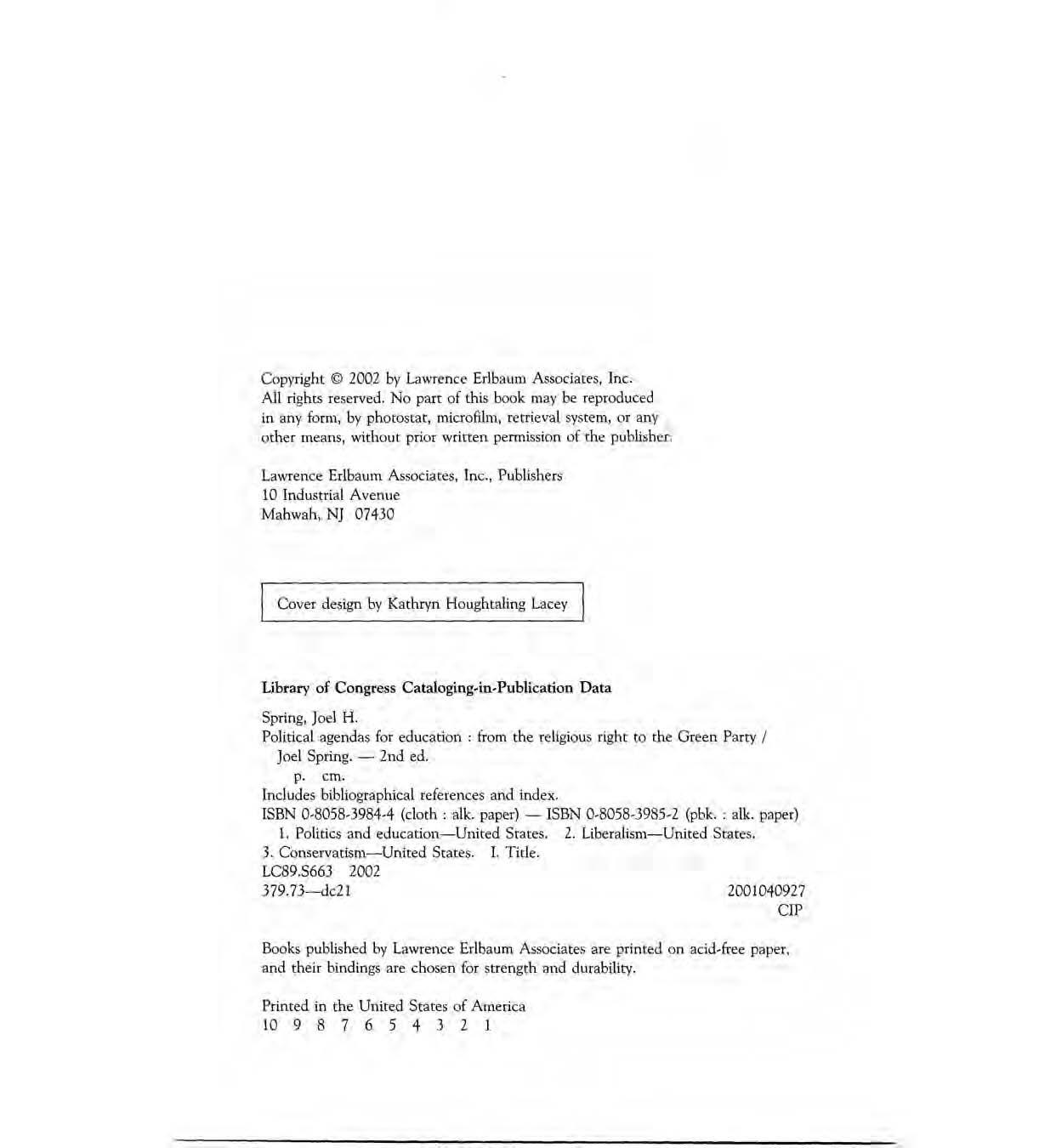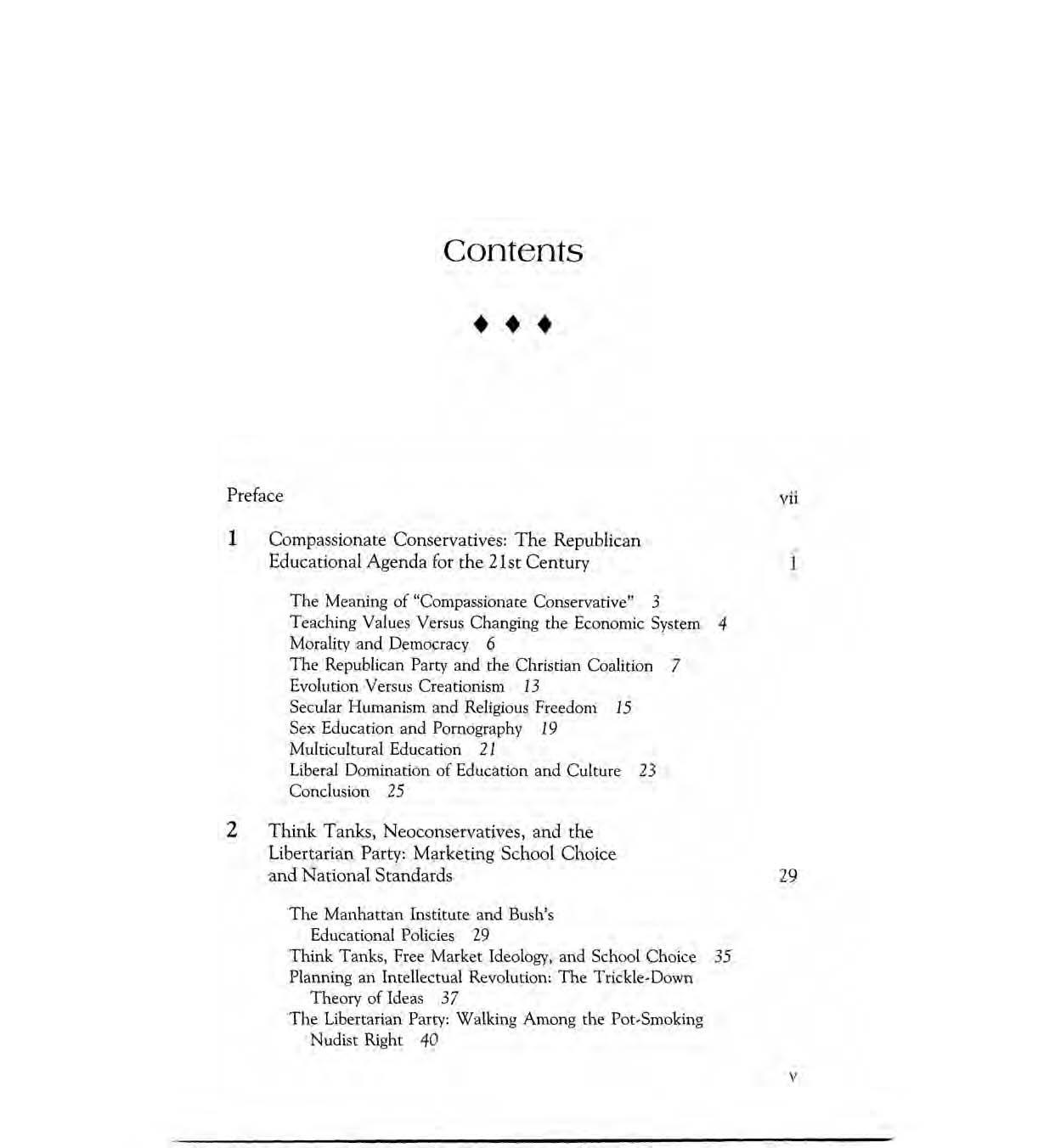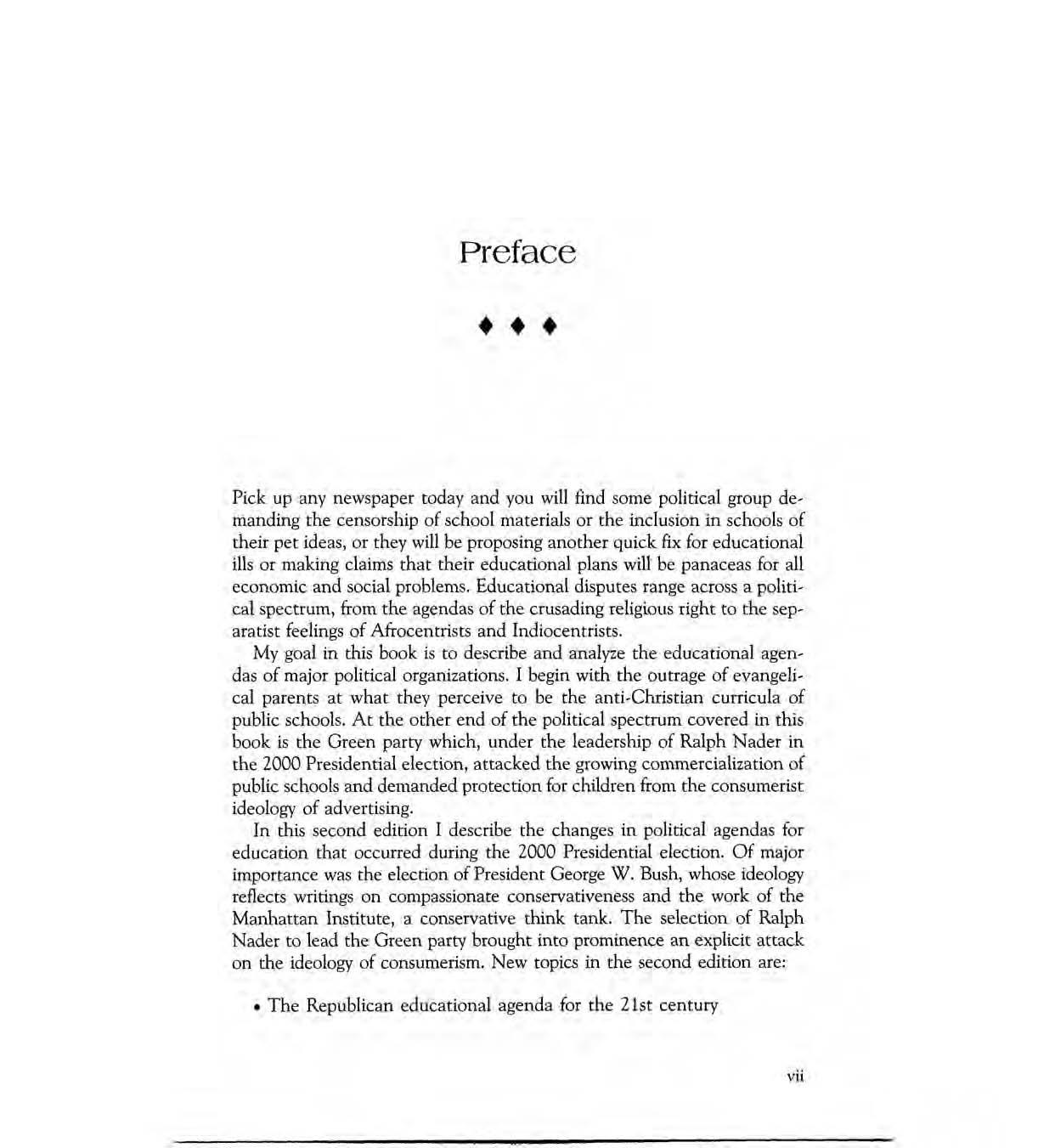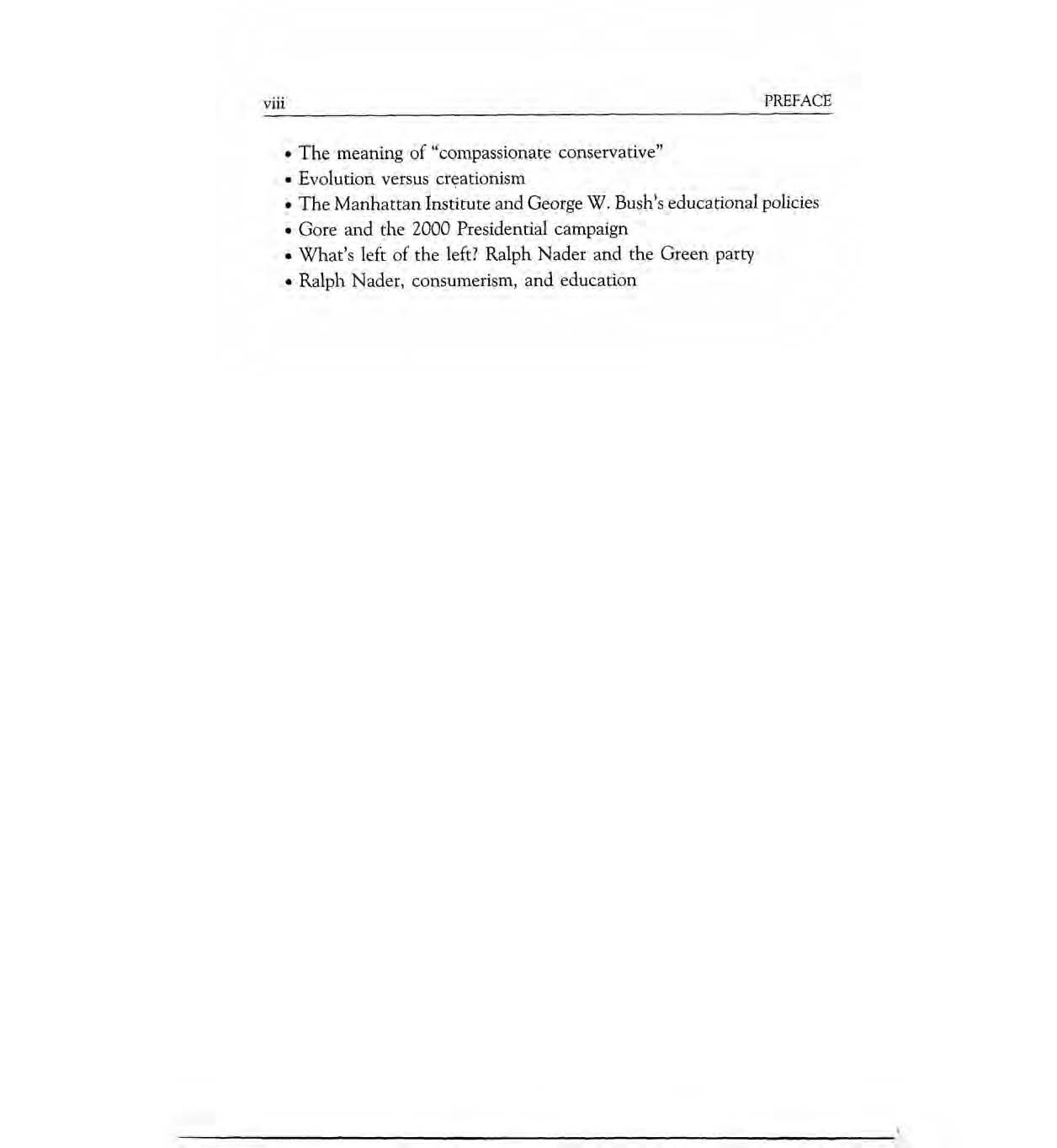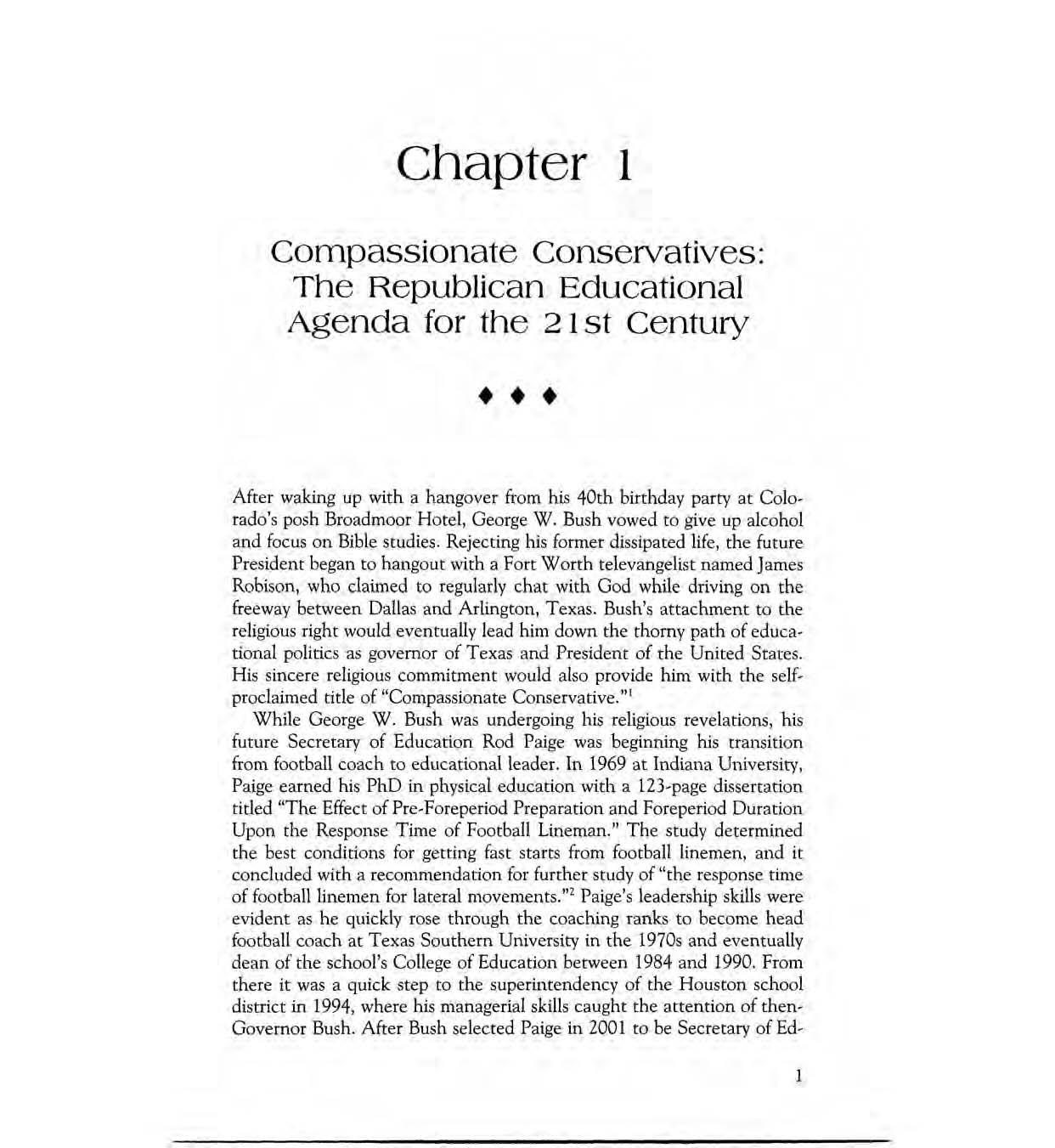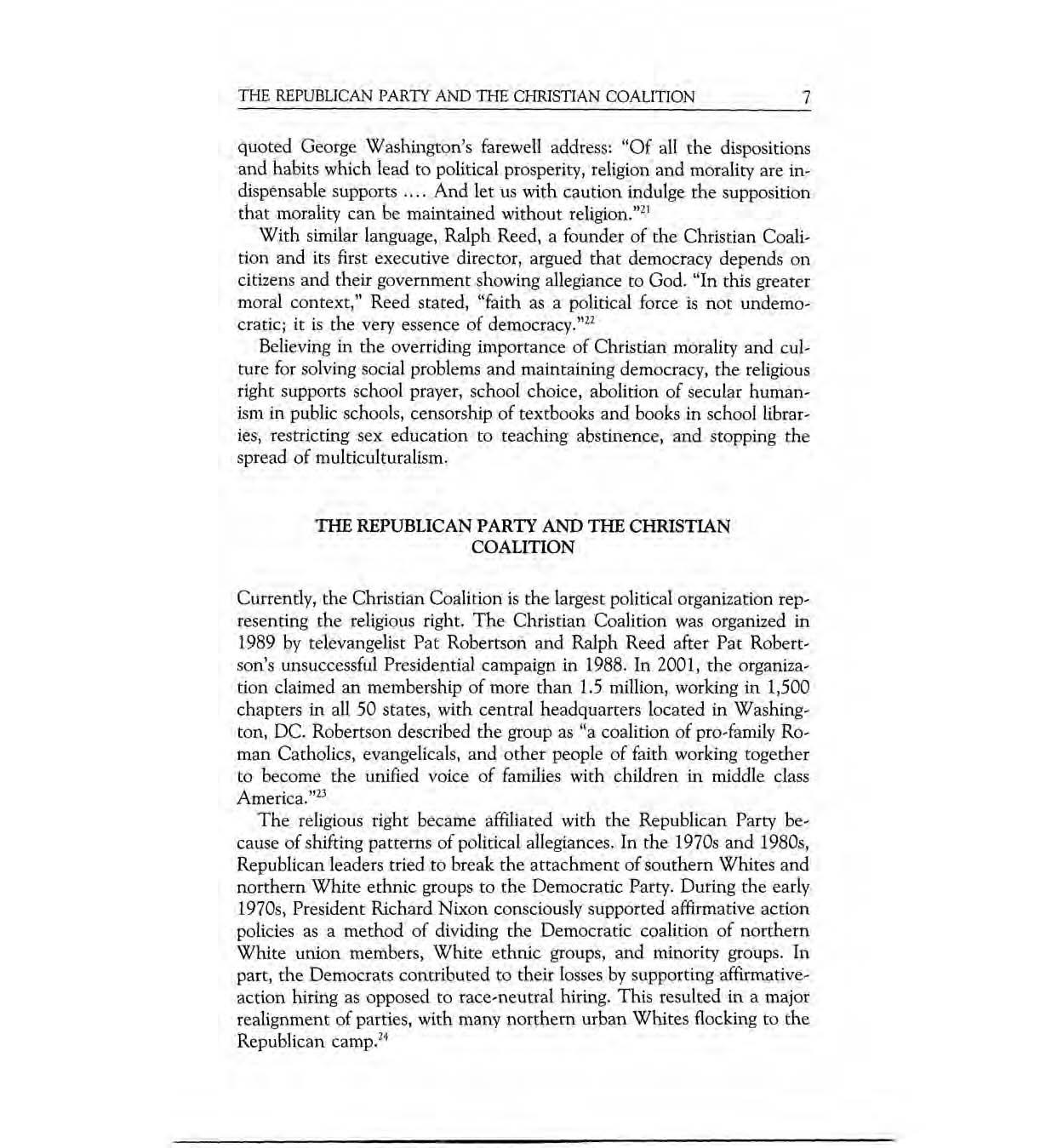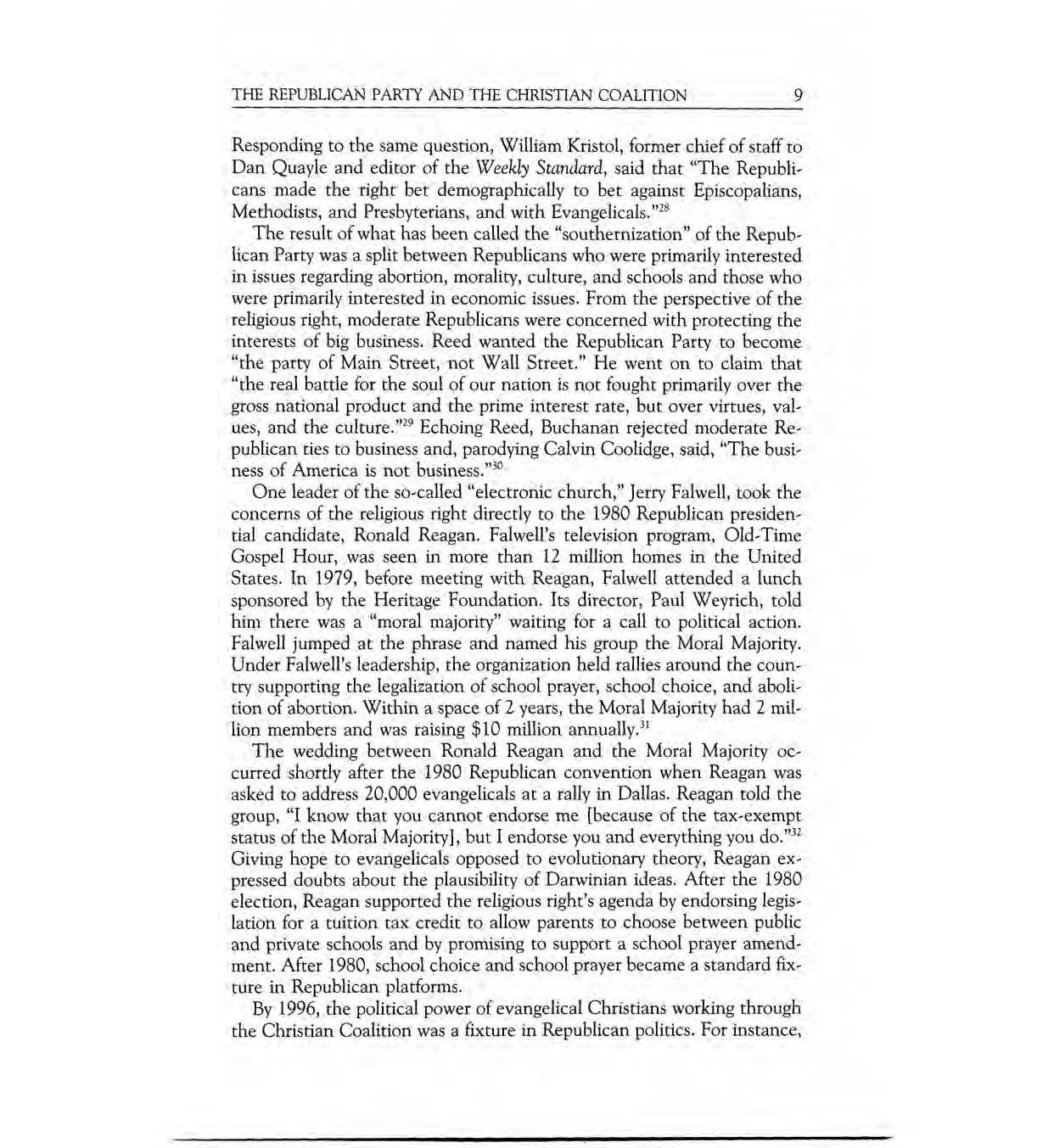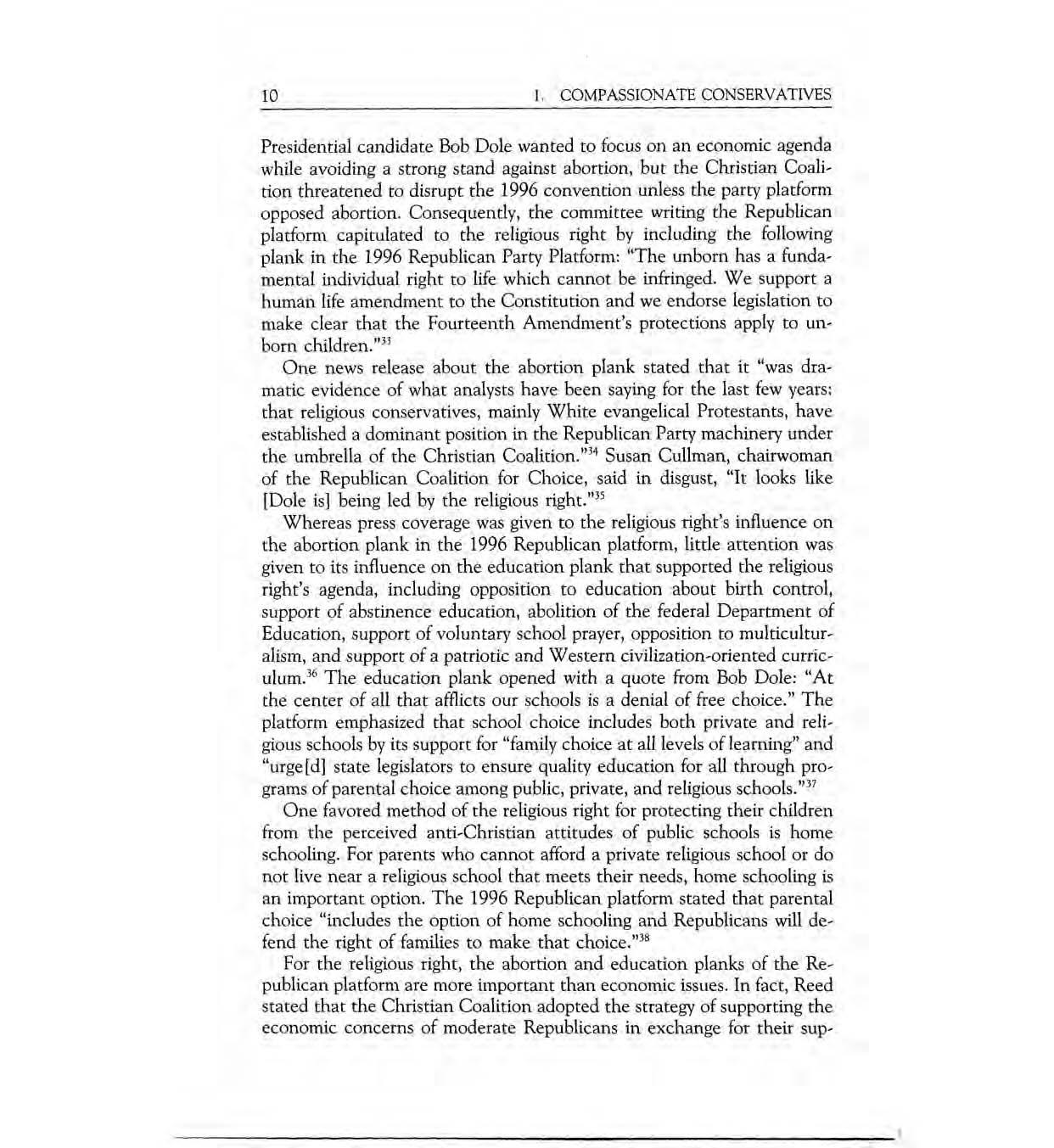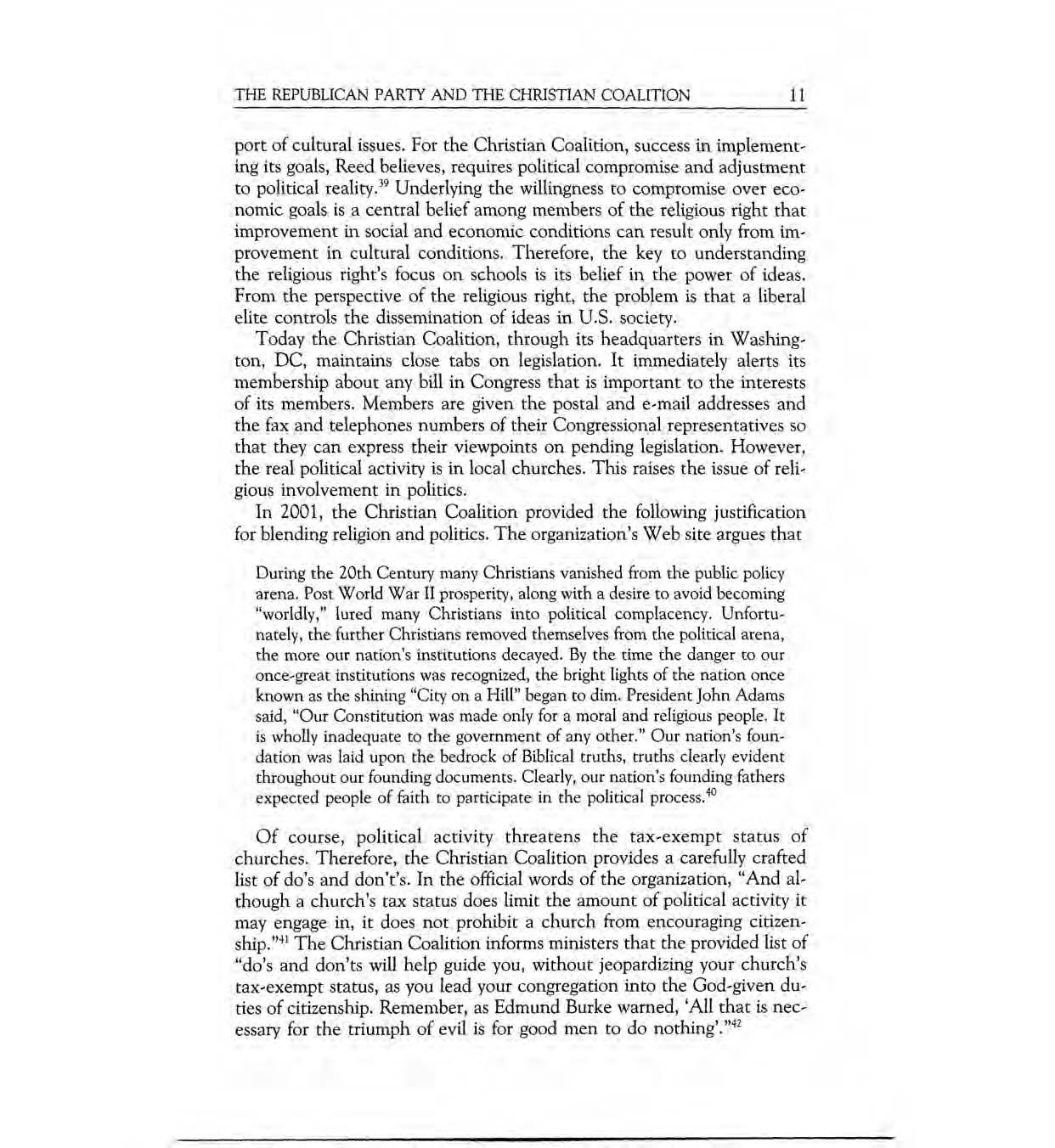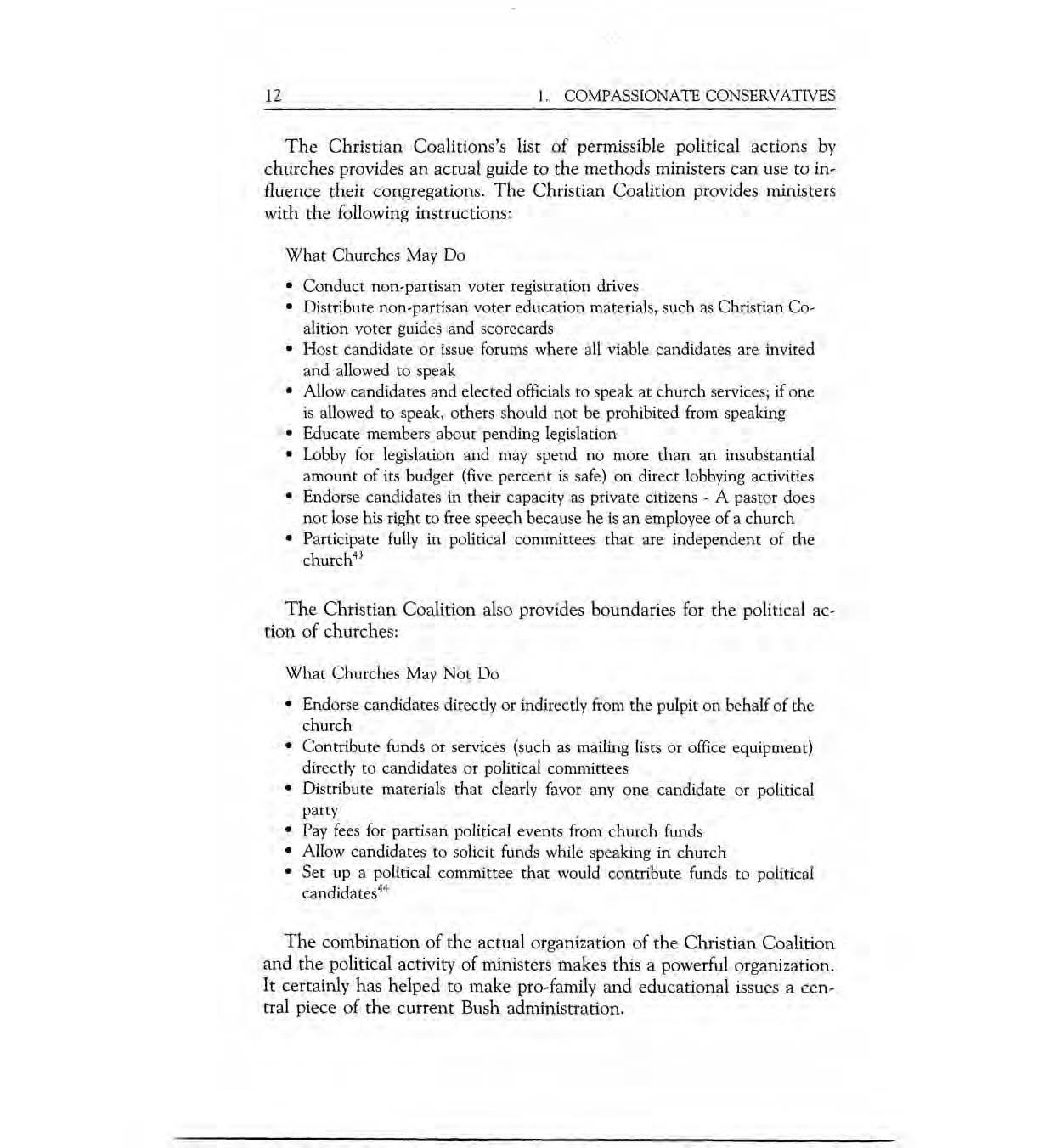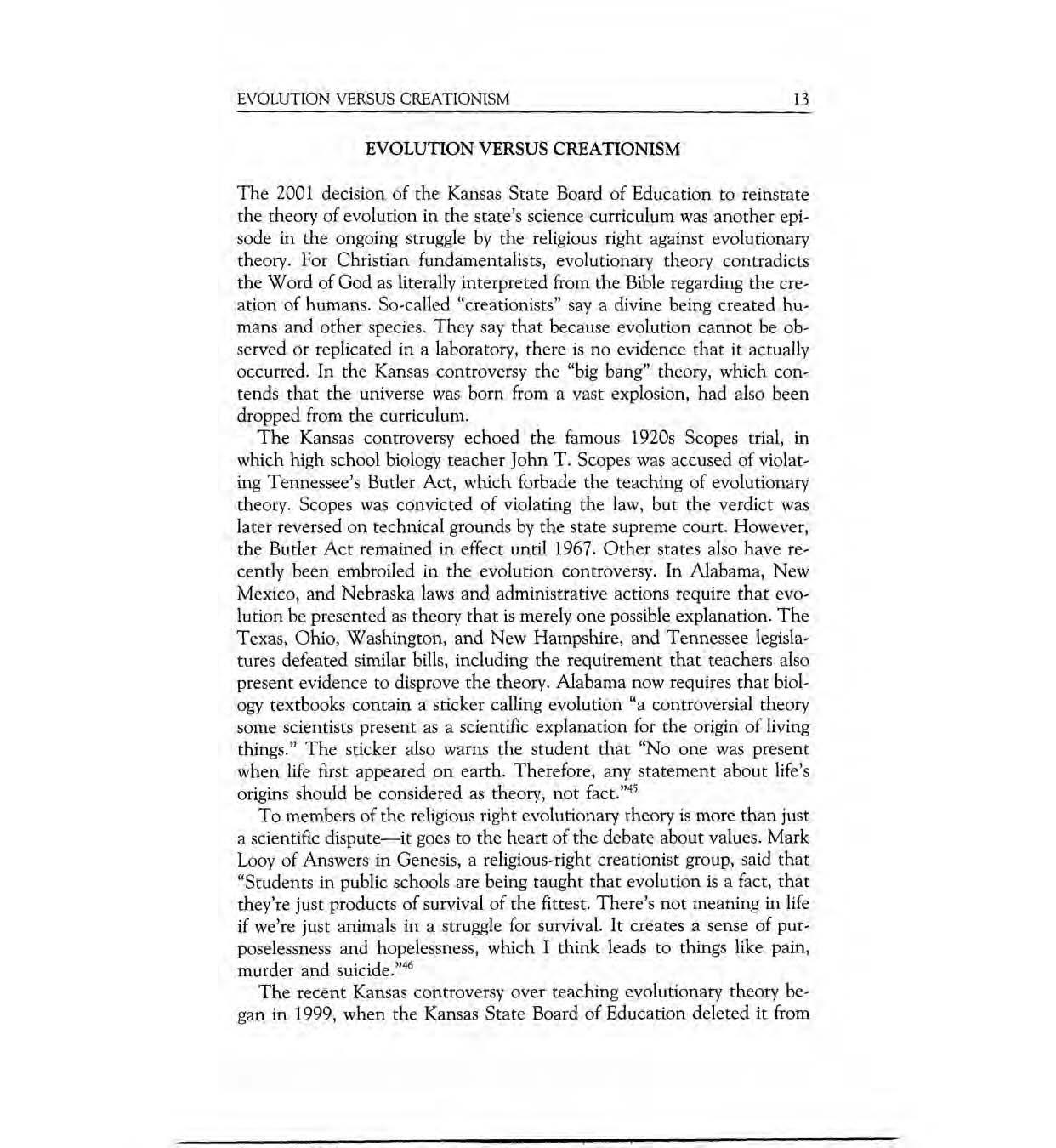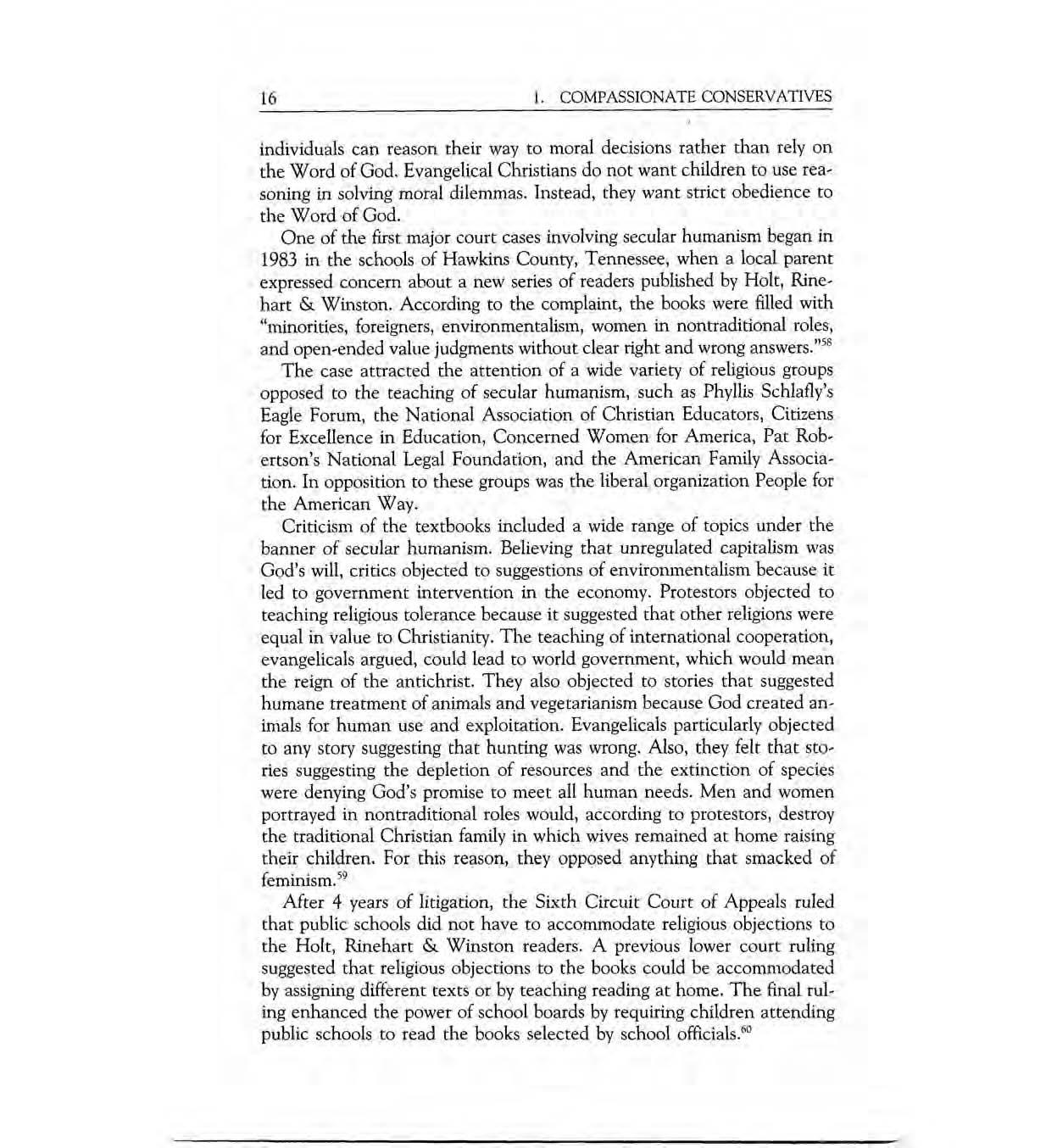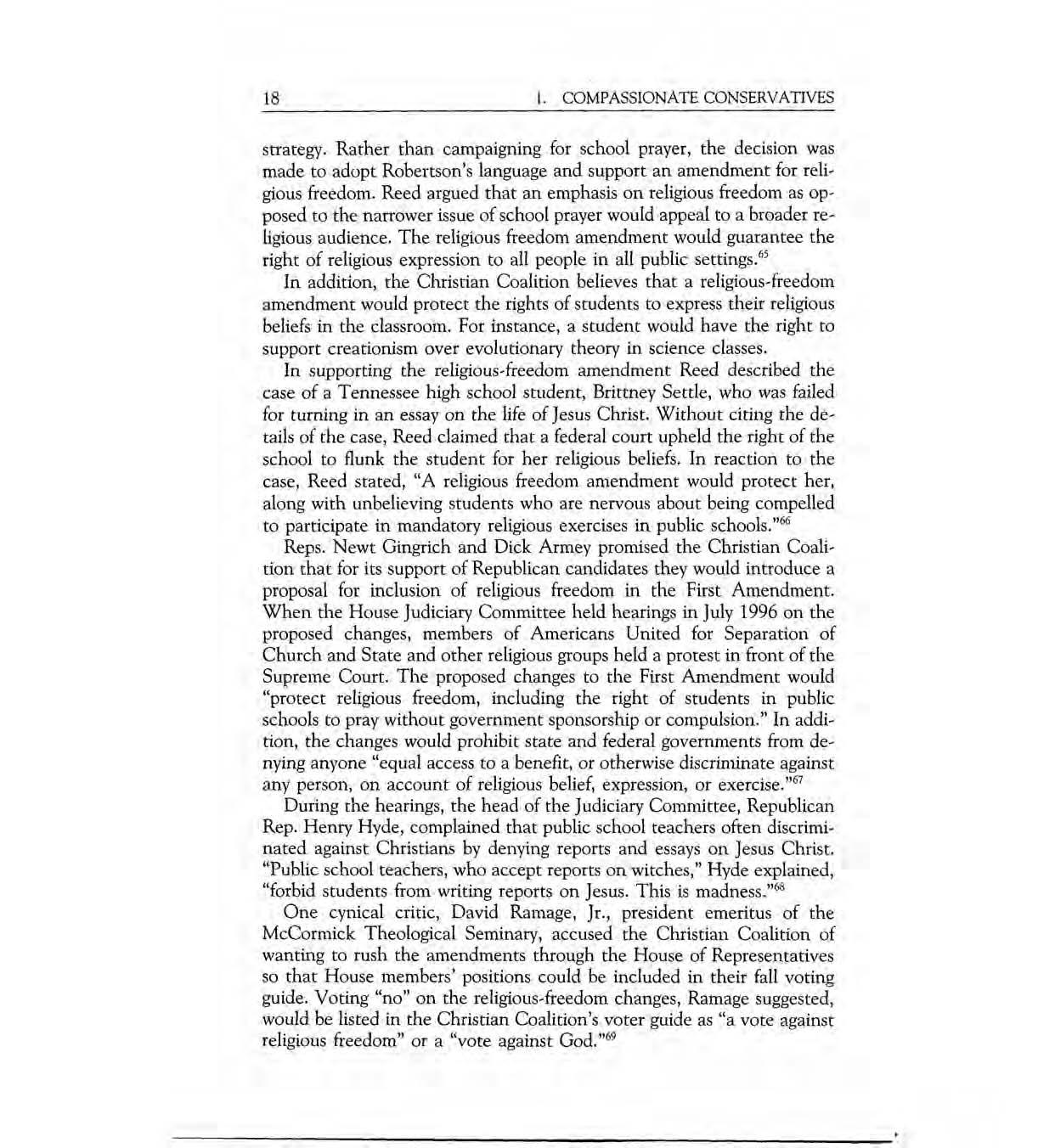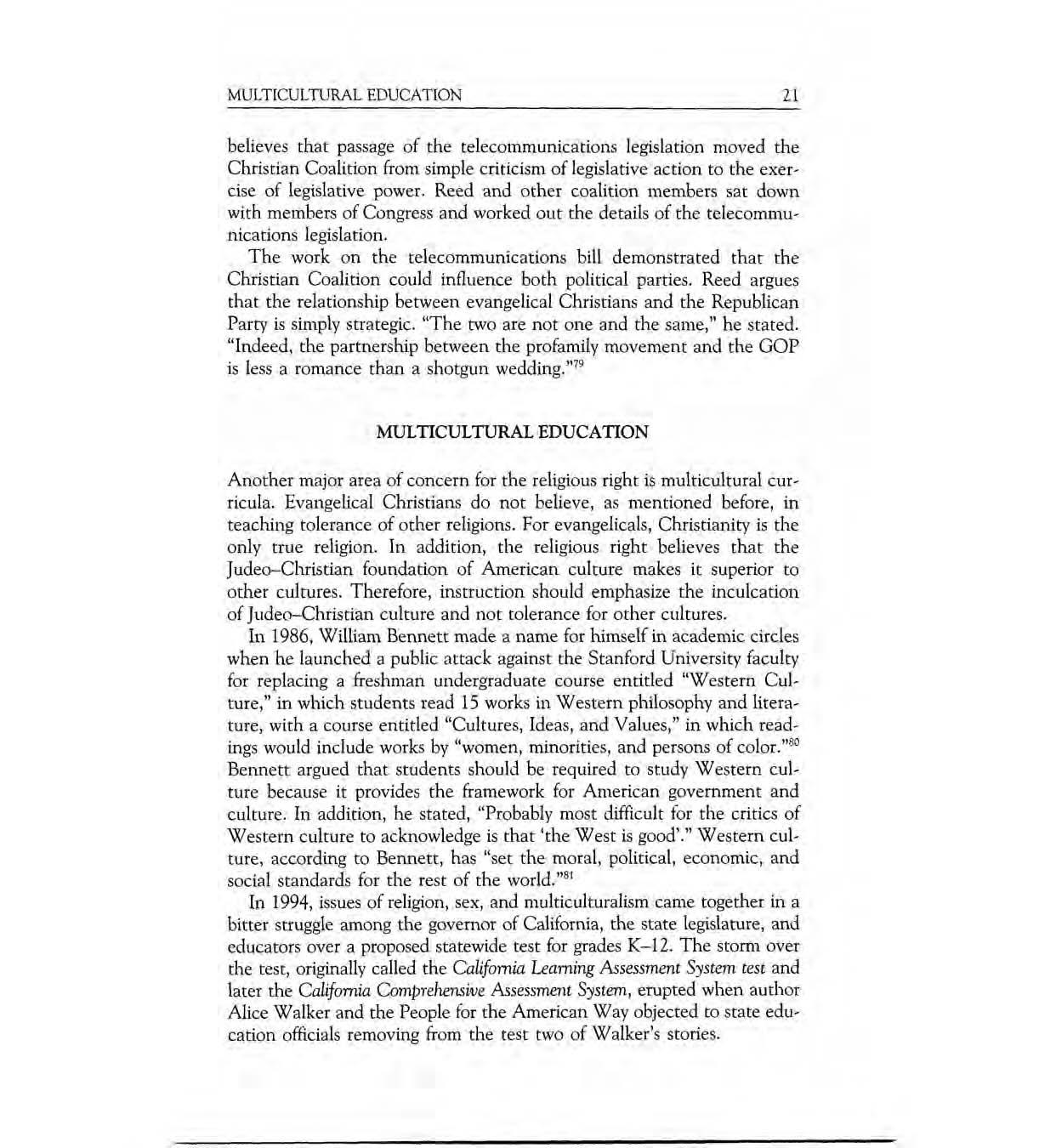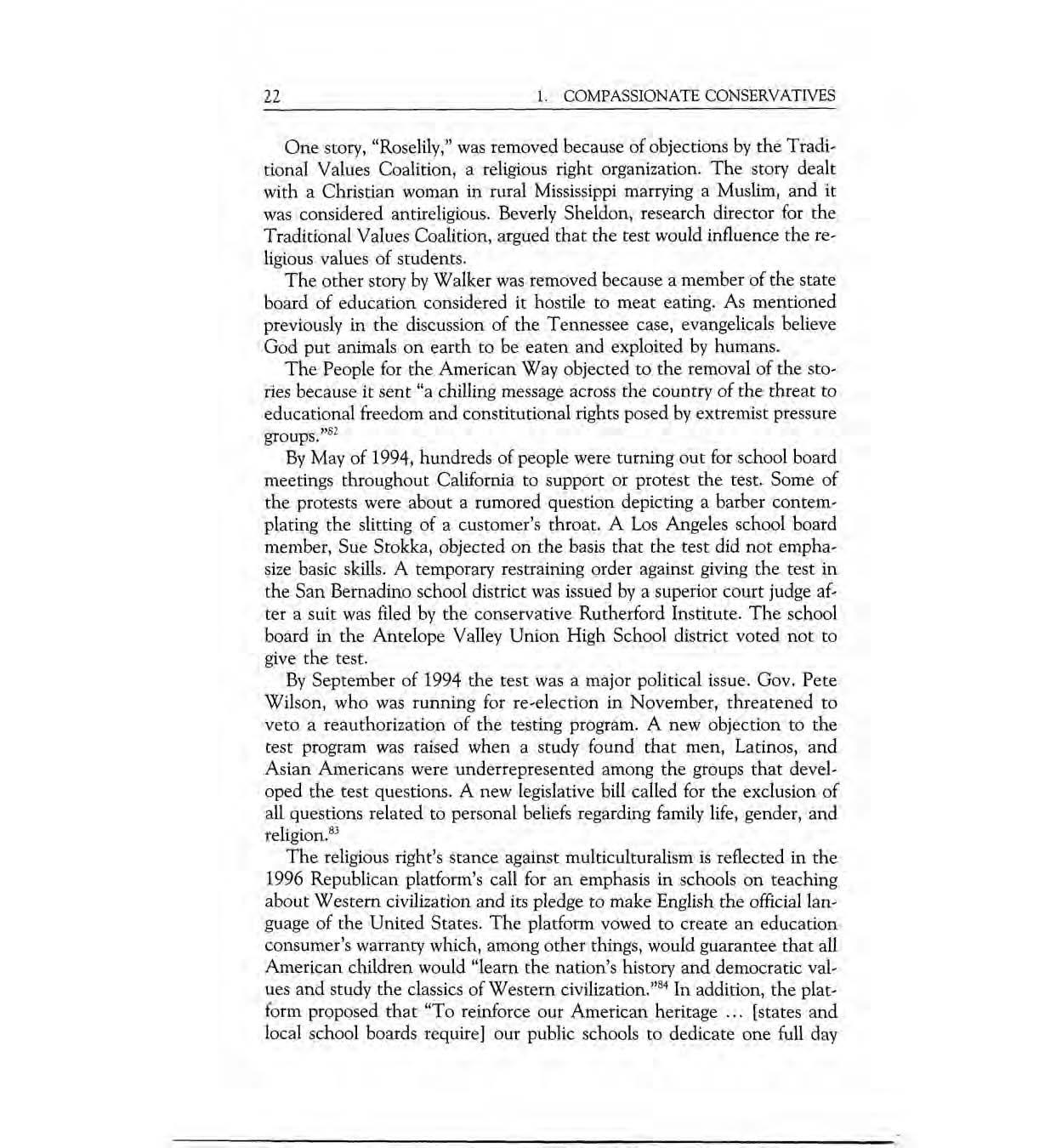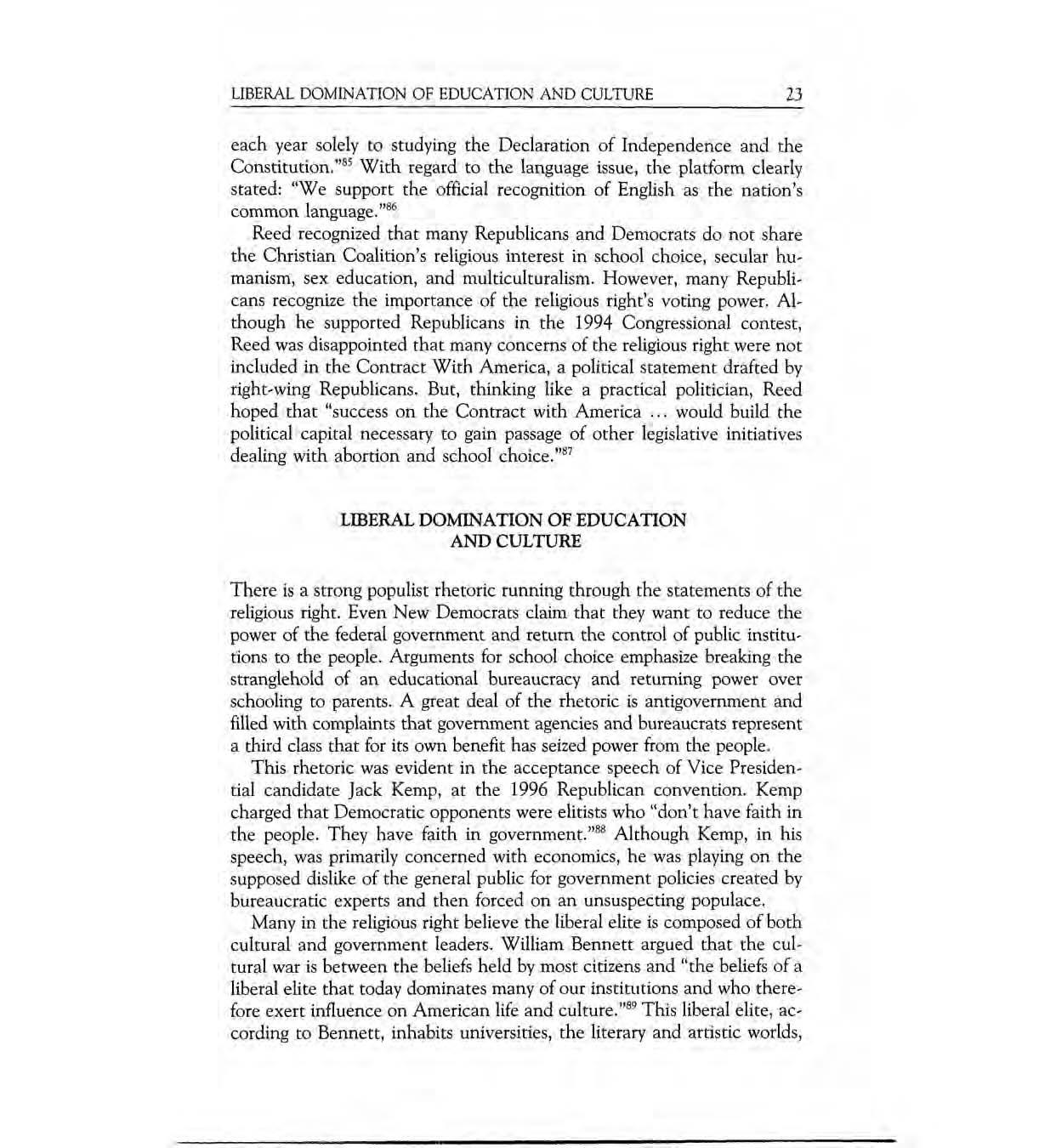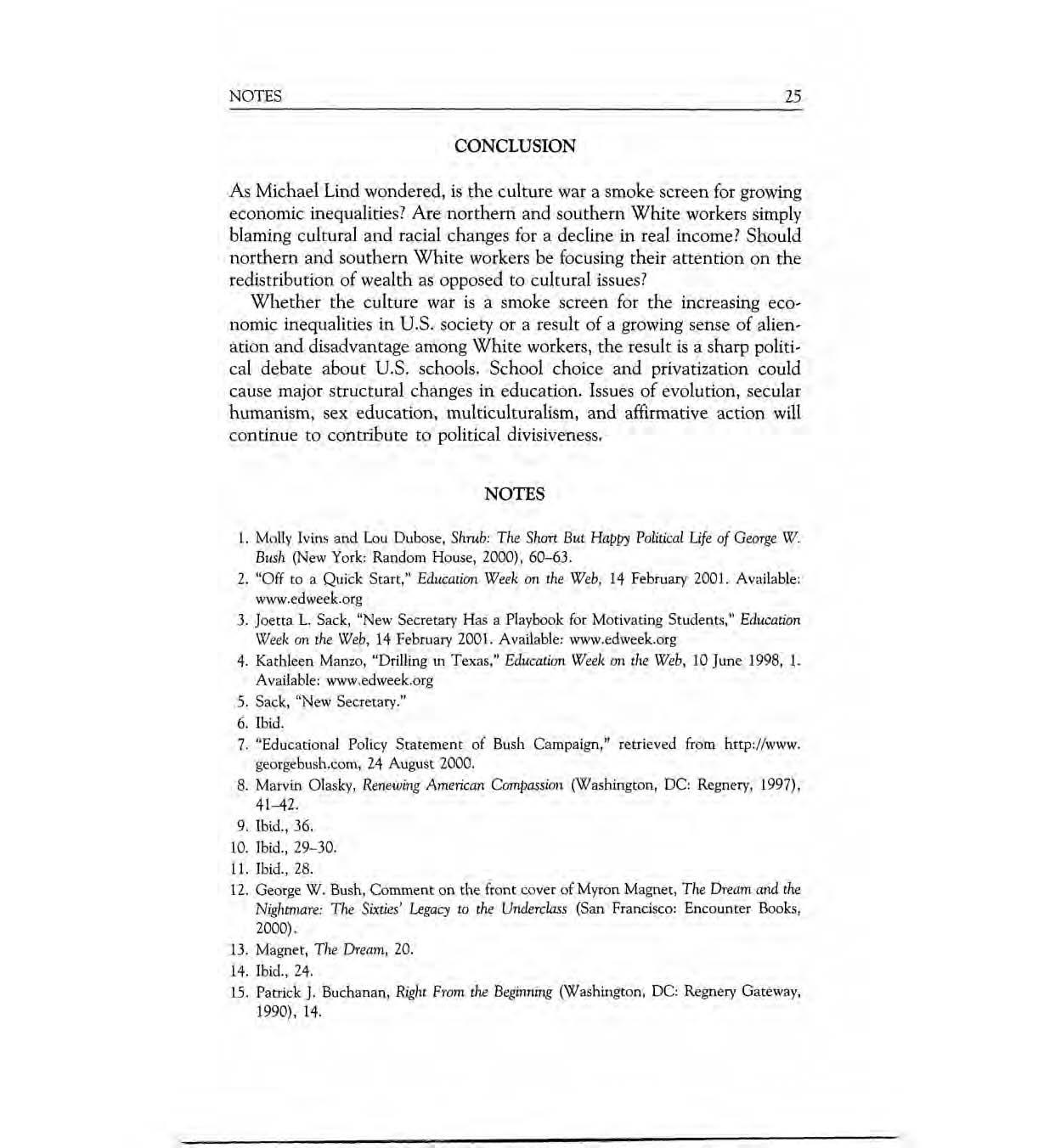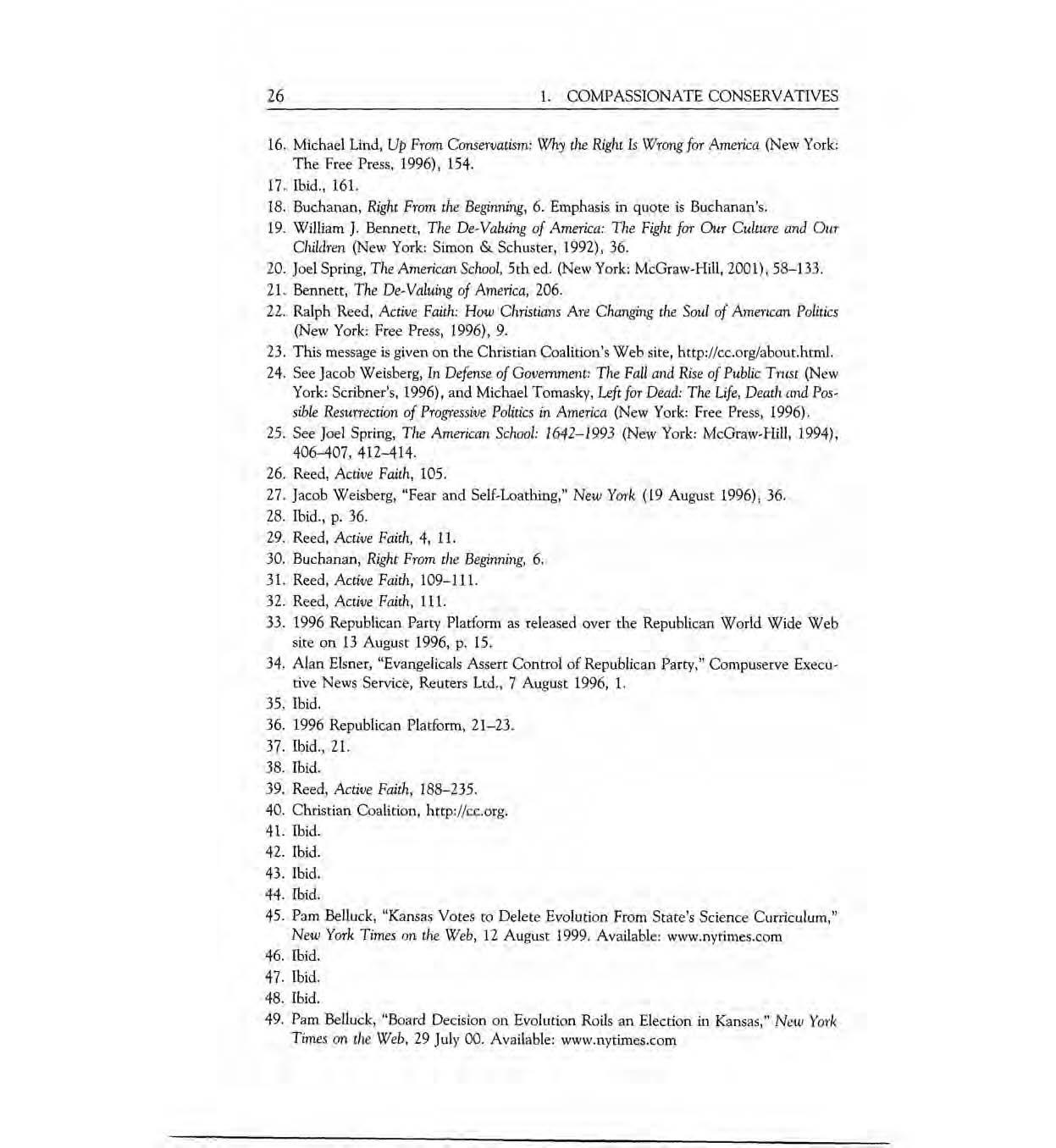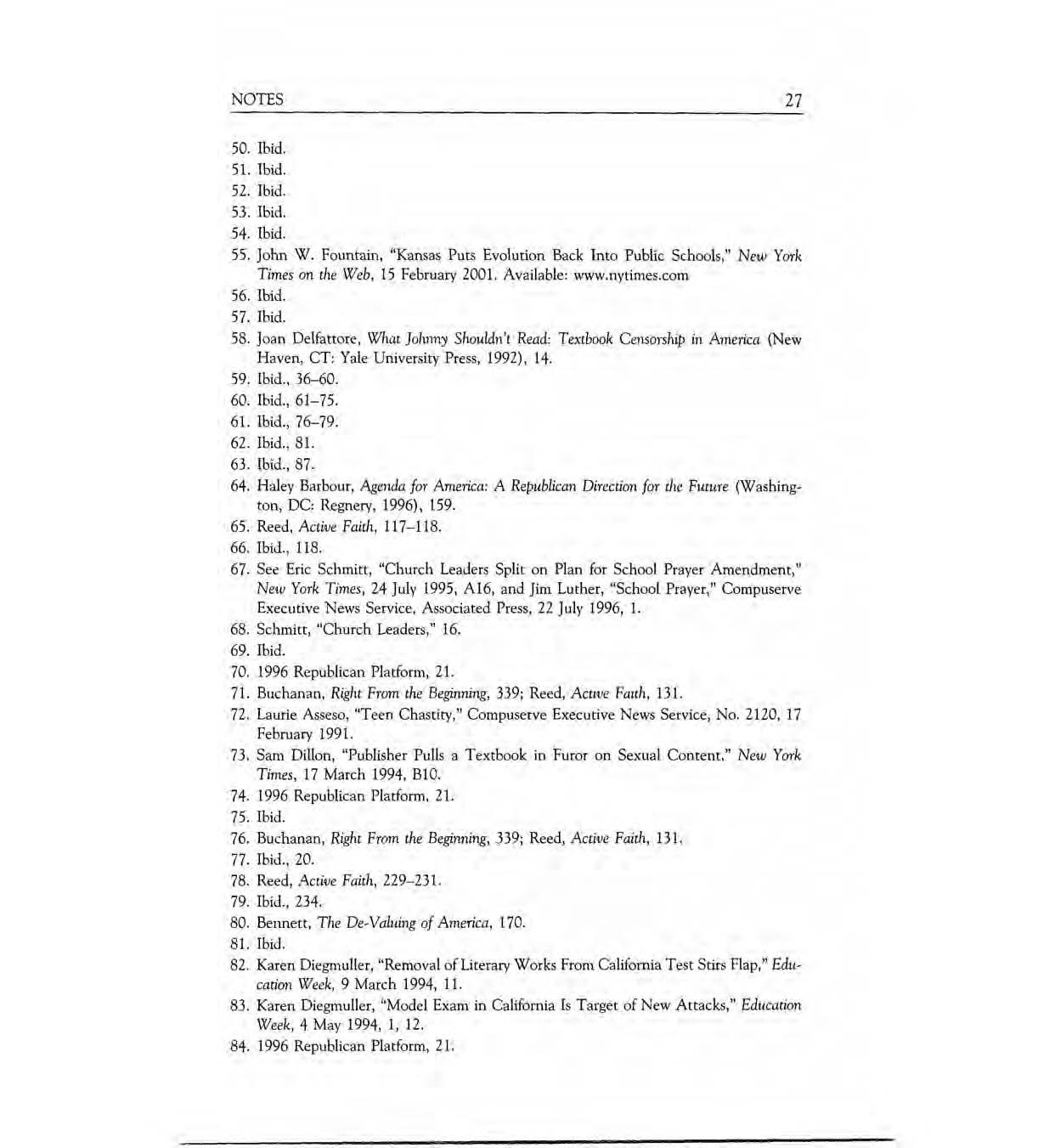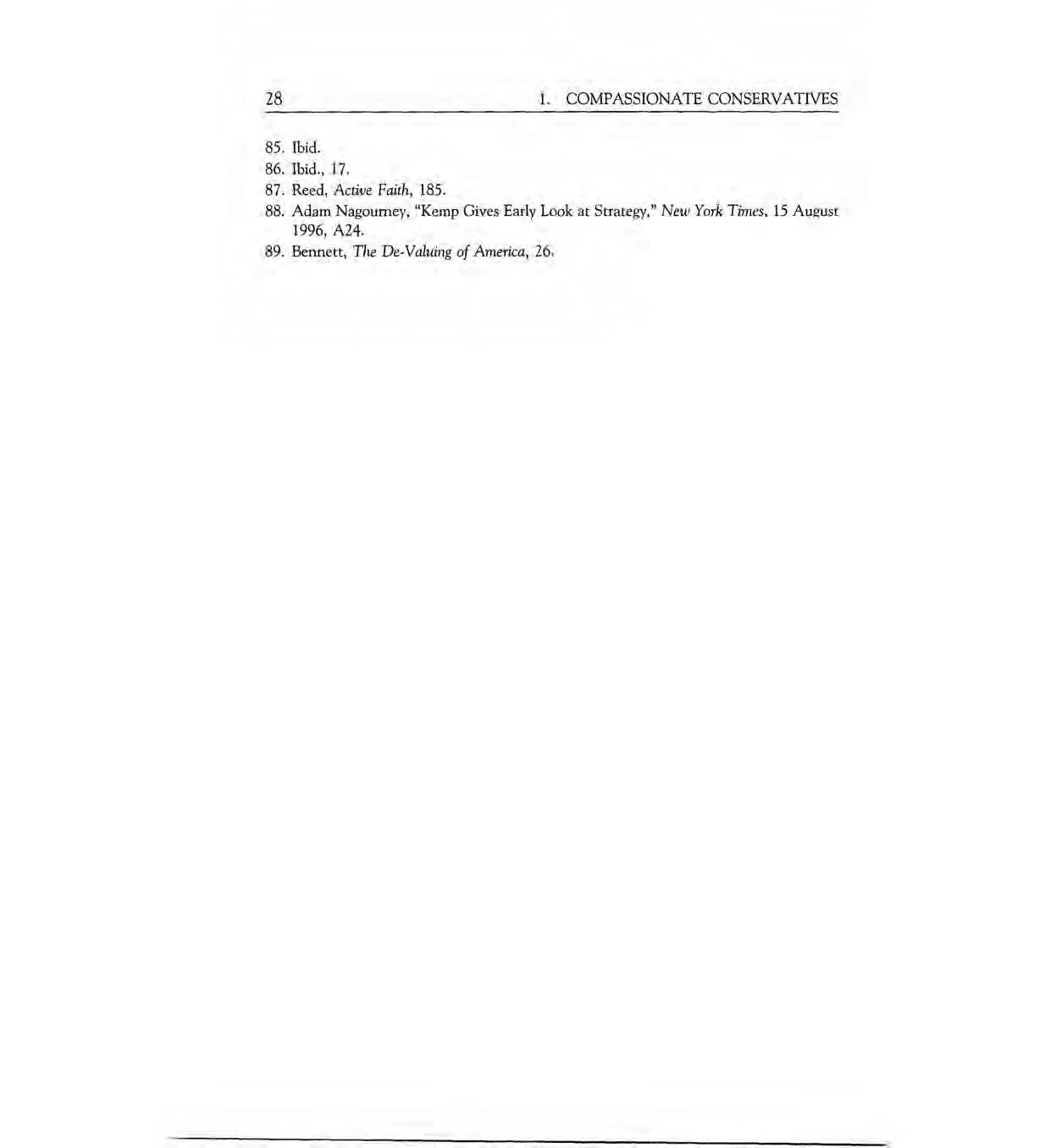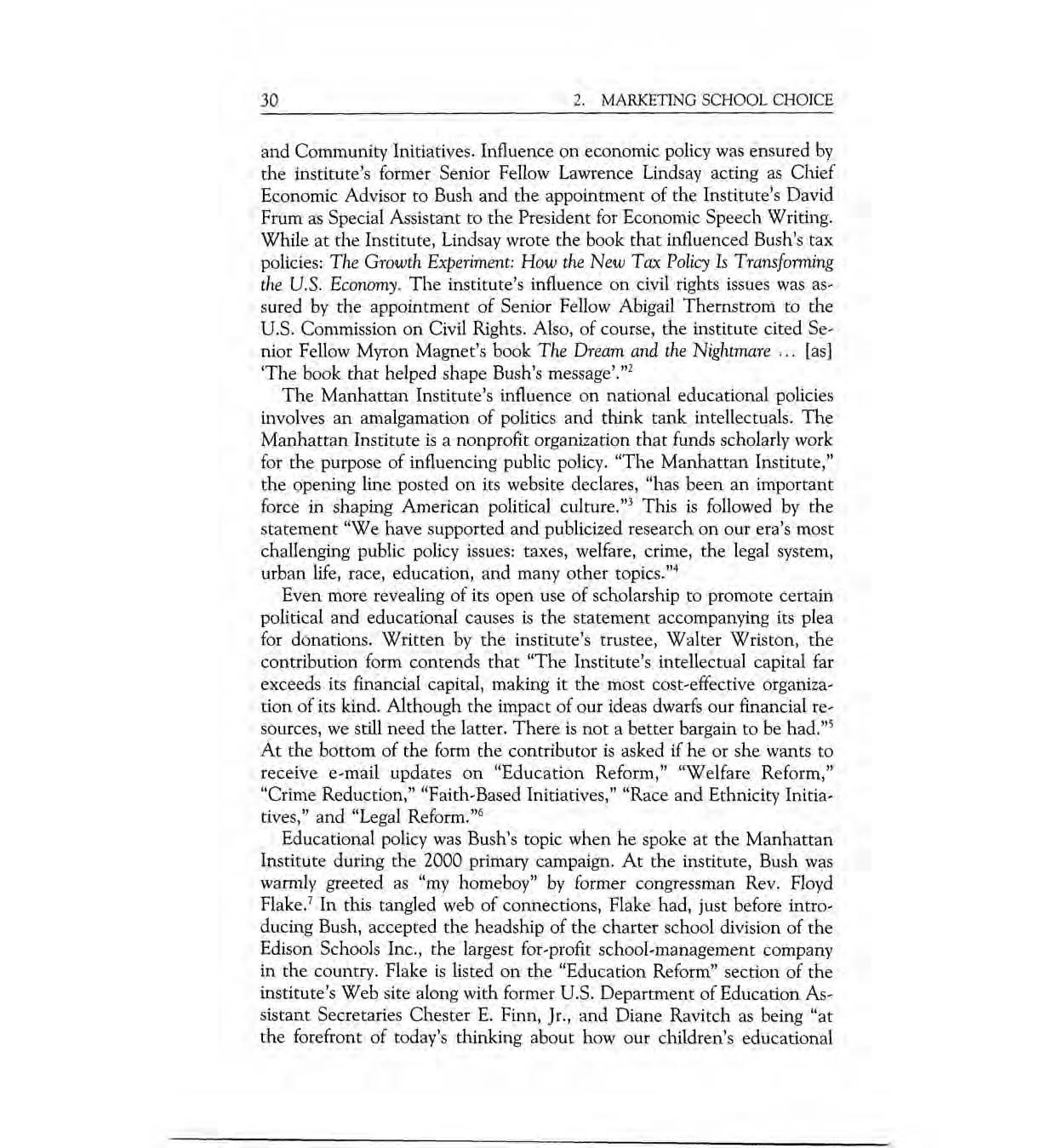Chapter 1 Compassionate Conservatives: The Republican Educational Agenda for the 2 1st Century
After waking up with a hangover from his 40th birthday party at Colorado’s posh Broadmoor Hotel, George W. Bush vowed to give up alcohol and focus on Bible studies. Rejecting his former dissipated life, the future President began to hangout with a Fort Worth televangelist named James Robison, who claimed to regularly chat with God while driving on the freeway between Dallas and Arlington, Texas. Bush’s attachment to the religious right would eventually lead him down the thorny path of educational politics as governor of Texas and President of the United States. His sincere religious commitment would also provide him with the selfproclaimed title of ‘Compassionate Conservative.”‘
While George W. Bush was undergoing his religious revelations, his future Secretary of Education RodPaigewas beginning his transition from football coach to educational leader. In 1969 at Indiana University, Paige earned his PhD in physical education with a 123-page dissertation titled “The Effect of Pre-Foreperiod Preparation and Foreperiod Duration Upon the Response Time of Football Lineman.” The study determined the best conditions for getting fast starts from football linemen, and it concluded with a recommendation for further study of “the response time of football linemen for lateral movements.”’ Paige’s leadership skills were evident as he quickly rose through the coaching ranks to become head football coach at Texas Southern University in the 1970s and eventually dean of the school’s College of Education between 1984 and 1990. From there it was a quick step to the superintendency of the Houston school district in 1994, where his managerial skills caught the attention of thenGovernor Bush. After Bush selected Paige in 2001 to be Secretary of Ed-
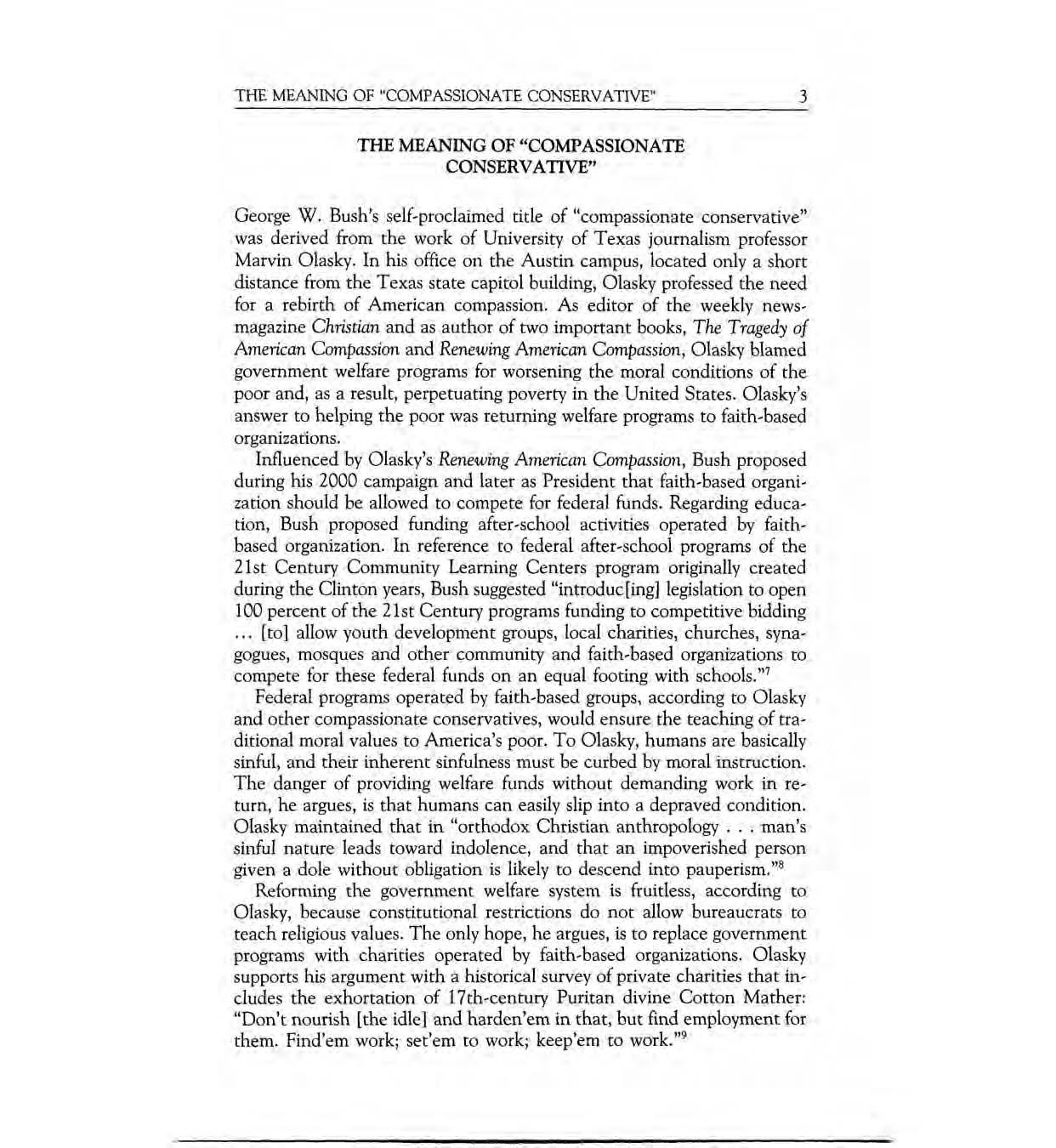
THE MEANING OF “COMPASSIONATE CONSERVATIVE”
George W. Bush’s self-proclaimed title of “compassionate conservative” was derived from the work of University of Texas journalism professor Marvin Olasky. In his office on the Austin campus, located only a short distance from the Texas state capitol building, Olasky professed the need for a rebirth of American compassion. As editor of the weeklynewsmagazine Christian and as author of two important books, The Tragedy of American Compassion and Renewing American Compassion,Olasky blamed government welfare programs for worsening the moral conditions of the poor and, as a result, perpetuating poverty in the United States. Olasky’s answer to helping the poor was returning welfare programs to faith-based organizations.
Influenced by Olasky’s Renewing American Compassion, Bush proposed during his 2000 campaign and later as President that faith-based organization should be allowed to compete for federal funds. Regarding education, Bush proposed funding after-school activities operated by faithbased organization. In reference to federal after-school programs of the 21st Century Community Learning Centers program originally created during the Clinton years, Bush suggested “introduc[ing] legislation to open 100 percent of the 21st Century programs funding to competitive bidding ... [to] allow youth development groups, local charities, churches, synagogues, mosques and other community and faith-based organizations to compete for these federal funds on an equal footing with school~.”~
Federal programs operated by faith-based groups, according to Olasky and other compassionate conservatives, would ensure the teaching of traditional moral values to America’s poor. To Olasky, humans are basically sinful, and their inherent sinfulness must be curbed by moral instruction. The danger of providing welfare funds without demanding work in return, he argues, is that humans can easily slip into a depraved condition. Olasky maintained that in “orthodox Christian anthropology ... man’s sinful nature leads toward indolence, and that an impoverished person given a dole without obligation is likely to descend into pauperism.”8
Reforming the government welfaresystem is fruitless, according to Olasky, because constitutional restrictions do not allow bureaucrats to teach religious values. The only hope, he argues, is to replace government programs with charities operated by faith-based organizations. Olasky supports his argument with a historical survey of private charities that includes the exhortation of 17th-century Puritan divine Cotton Mather: “Don’t nourish [the idle] and harden’em in that, butfind employment for them. Find’em work; set’em to work; keep’em to work.”’
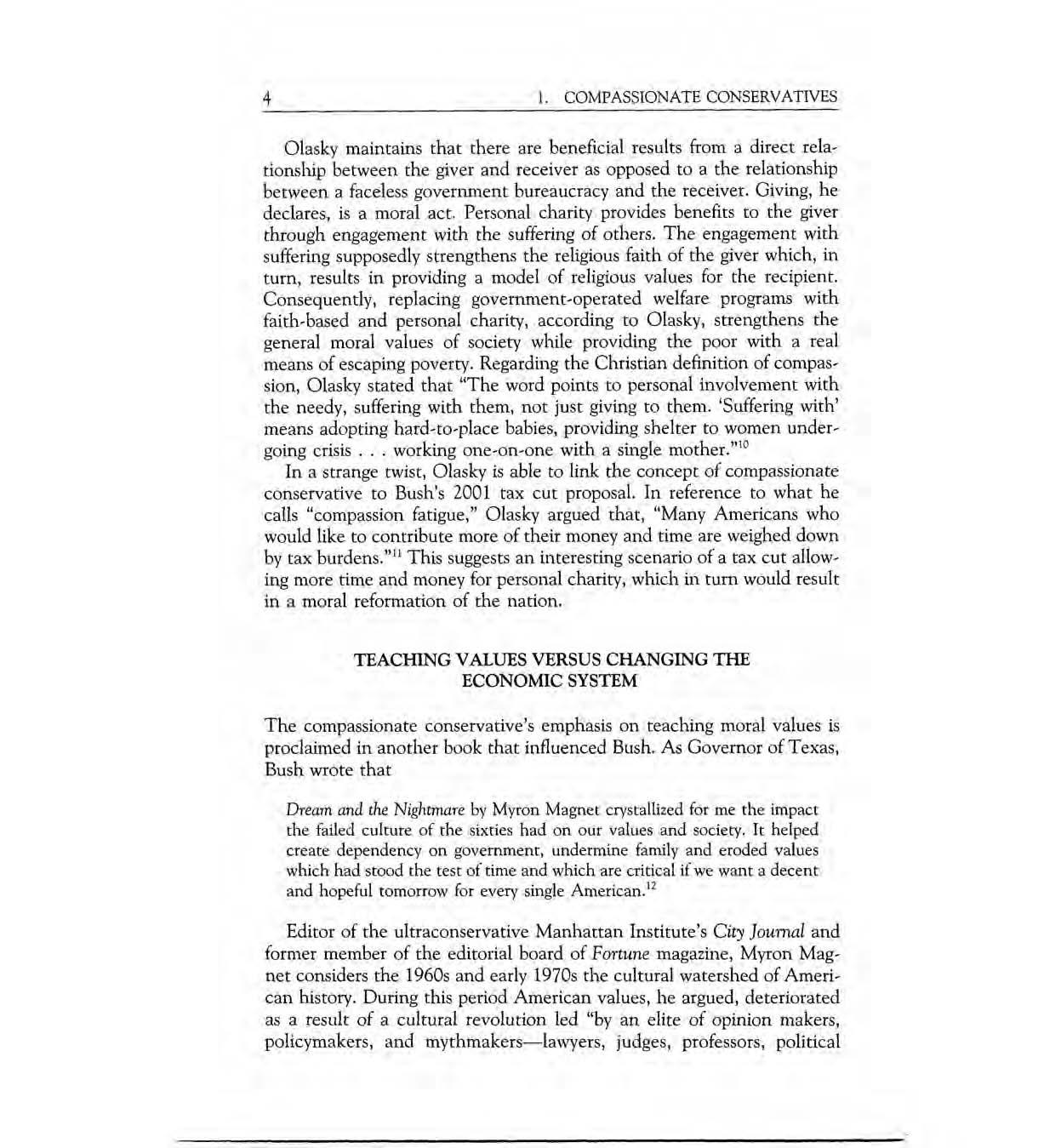
Olasky maintains that there are beneficial results from a direct relationship between the giver and receiver as opposed to a the relationship between a faceless government bureaucracy and the receiver. Giving, he declares, is a moral act. Personal charity provides benefits to the giver through engagement with the suffering of others. The engagement with suffering supposedly strengthens the religious faith of the giver which, in turn, results in providing a model of religious values for the recipient. Consequently, replacing government-operated welfare programs with faith-based and personal charity, according to Olasky, strengthensthe general moral values of societywhile providing the poor witha real means of escaping poverty. Regarding the Christian definition of compassion, Olasky stated that “The word points to personal involvement with the needy, suffering with them, not just giving to them. ‘Suffering with’ means adopting hard-to-place babies, providing shelter to women undergoing crisis ... working one-on-one with a single mother.””
In a strange twist, Olasky is able to link the concept of compassionate conservative to Bush’s2001 tax cut proposal. In reference to what he calls “compassion fatigue,” Olasky argued that, “Many Americans who would like to contribute more of their money and time are weighed down by tax burdens.”” This suggests an interesting scenario of a tax cut allowing more time and money for personal charity, which in turn would result in a moral reformation of the nation.
TEACHING VALUES VERSUS CHANGING THE ECONOMIC SYSTEM
The compassionate conservative’s emphasis on teaching moral values is proclaimed in another book that influenced Bush. As Governor of Texas, Bush wrote that
Dream and the Nightmare by Myron Magnet crystallized for me the impact the failed culture of the sixties had on our vaIues and society. It helped create dependency on government, undermine family and eroded values which had stood the test of time and which are critical if we want a decent and hopeful tomorrow for every single American.”
Editor of the ultraconservative Manhattan Institute’s City Journal and former member of the editorial board of Fortune magazine, Myron Magnet considers the 1960s and early 1970s the cultural watershed of American history. During this period American values, he argued, deteriorated as a result of a cultural revolution led “by an elite of opinion makers, policymakers, and mythmakers-lawyers, judges, professors, political
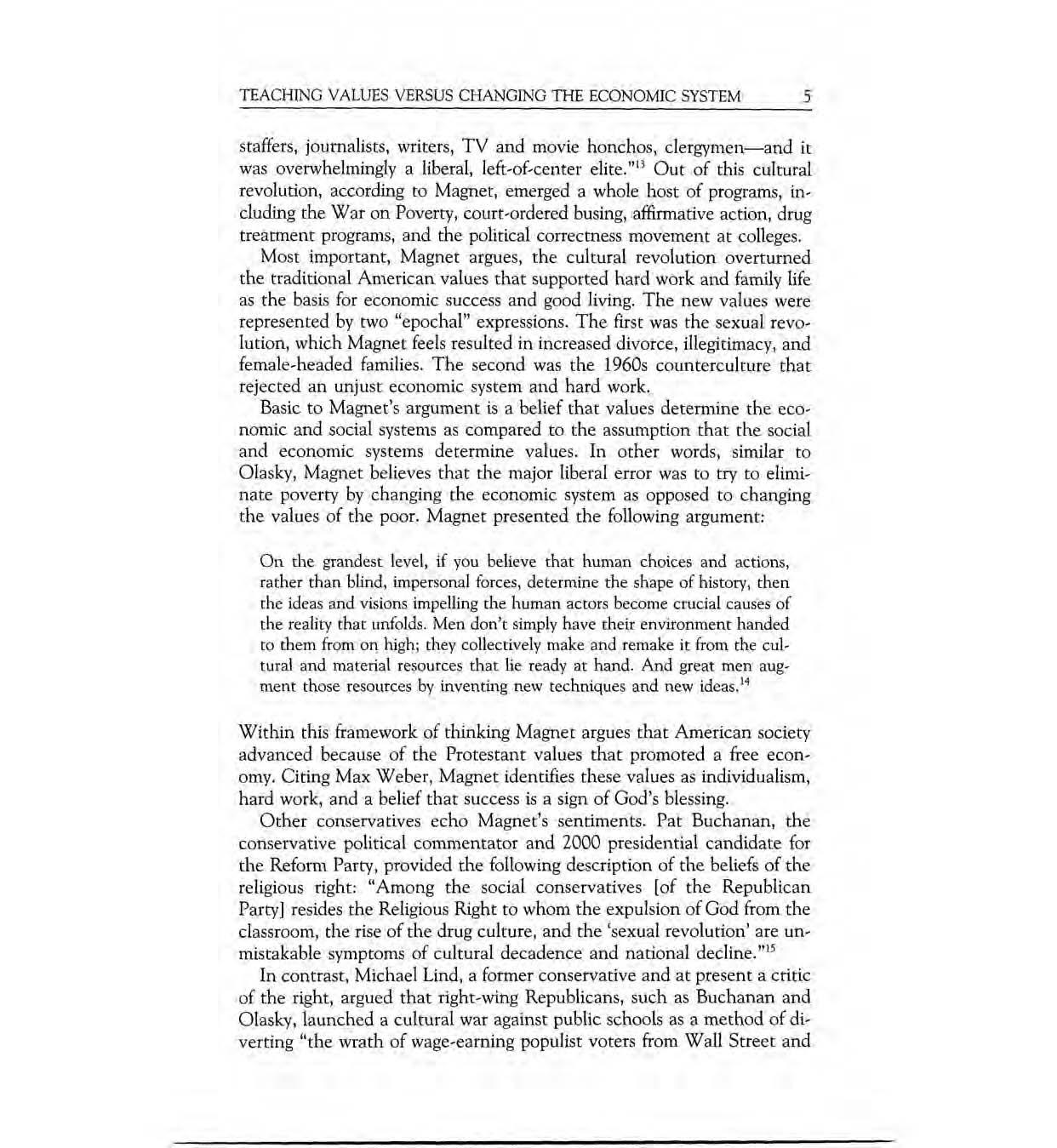
staffers, journalists, writers, TV and movie honchos, clergymen-and it wasoverwhelmingly a liberal, left-of-center elite.”13 Out of this cultural revolution, according to Magnet, emerged a whole host of programs, including the War on Poverty, court-ordered busing, affirmative action, drug treatment programs, and the political correctness movement at colleges. Most important, Magnet argues, thecultural revolution overturned the traditional American values that supported hard work and family life as the basis for economic success and good living. The new values were represented by two “epochal” expressions. The first was the sexual revolution, which Magnet feels resulted in increased divorce, illegitimacy, and female-headed families. The second was the 1960s counterculture that rejected an unjust economic system and hard work.
Basic to Magnet’s argument is a belief that values determine the economic and social systems as compared to the assumption that the social and economic systems determine values. Inother words,similar to Olasky, Magnet believes that the major liberal error was to try to eliminate poverty by changing the economic system as opposed to changing the values of the poor. Magnet presented the following argument:
On the grandest level, ifyoubelieve that humanchoicesandactions, rather than blind, impersonal forces, determine the shapeof history, then the ideas and visions impelling the human actors become crucial causesof the reality that unfolds. Men don’t simply have their environment handed to them from on high; they collectively make and remake it from the cultural and material resources that lie ready at hand. And great men augment those resources by inventing new techniques and new ideas.14
Within this framework of thinking Magnet argues that American society advanced because of the Protestant values that promoted a free economy. Citing Max Weber, Magnet identifies these values as individualism, hard work, and a belief that success is a sign of God’s blessing.
Other conservatives echo Magnet’s sentiments. PatBuchanan,the conservative political commentator and 2000 presidential candidate for the Reform Party, provided the following description of the beliefs of the religious right: “Among the social conservatives [of the Republican Party] resides the Religious Right to whom the expulsion of God from the classroom, the rise of the drug culture, and the ‘sexual revolution’ are unmistakable symptoms of cultural decadence and national decline.”15
In contrast, Michael Lind, a former conservative and at present a critic of the right, argued that right-wing Republicans, such as Buchanan and Olasky, launched a cultural war against public schools as a method of diverting “the wrath of wage-earning populist voters from Wall Street and
quoted George Washington’s farewell address: “Of all the dispositions and habits which lead to political prosperity, religion and morality are indispensable supports .... And let us with caution indulge the supposition that morality can be maintained without religion.””
With similar language, Ralph Reed, a founder of the Christian Coalition and its first executive director, argued that democracy depends on citizens and their government showing allegiance to God. “In this greater moral context,” Reed stated, “faith as a political force is not undemocratic; it is the very essence of democracy.”22
Believing in the overriding importance of Christian morality and culture for solving social problems and maintaining democracy, the religious right supports school prayer, school choice, abolition of secular humanism in public schools, censorship of textbooks and books in school libraries, restricting sex education to teaching abstinence, and stopping the spread of multiculturalism.
THE REPUBLICAN PARTYAND THE CHRISTIAN COALITION
Currently, the Christian Coalition is the largest political organization rep4 resenting the religious right. The Christian Coalition was organized in 1989 by televangelist Pat Robertson and Ralph Reed after Pat Robertson’s unsuccessful Presidential campaign in 1988. In 2001, the organization claimed an membership of more than 1.5 million, working in 1,500 chapters in all 50 states, with central headquarters located in Washington, DC. Robertson described the group as “a coalition of pro#familyRoman Catholics, evangelicals, and other people of faith working together to become the unifiedvoice of families with children in middle class America.”23
The religious right became affiliated with the Republican Party because of shifting patterns of political allegiances. In the 1970s and 1980s, Republican leaders tried to break the attachment of southern Whites and northern White ethnic groups to the Democratic Party. During the early 1970s’ President Richard Nixon consciously supported affirmative action policies as a method of dividing the Democratic coalition of northern White union members, White ethnic groups, and minority groups. In part, the Democrats contributed to their losses by supporting affirmativeaction hiring as opposed to race-neutral hiring. This resulted in a major realignment of parties, with many northern urban Whites flocking to the Republican camp.24
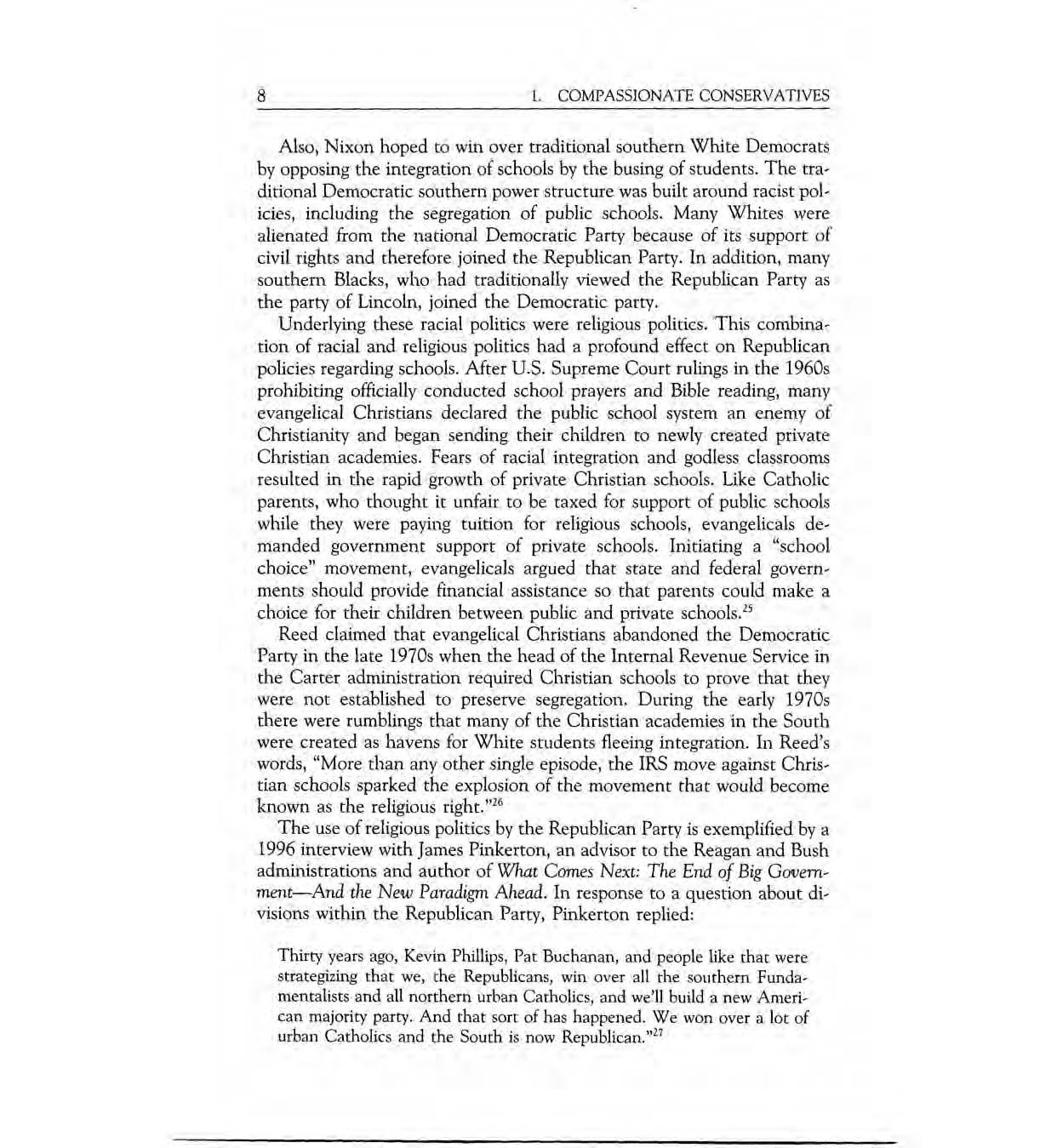
Also, Nixon hoped to win over traditional southern White Democrats by opposing the integration of schools by the busing of students. The traditional Democratic southern power structure was built around racist policies, including the segregation of public schools. Many Whites were alienated from the national Democratic Party because of its support of civil rights and therefore joined the Republican Party. In addition, many southern Blacks, who had traditionally viewed the Republican Party as the party of Lincoln, joined the Democratic party.
Underlying these racial politics were religious politics. This combination of racial and religious politics had a profound effect on Republican policies regarding schools. After U.S. Supreme Court rulings in the 1960s prohibiting officially conducted school prayers and Bible reading, many evangelical Christians declared the public school system an enemy of Christianity and began sending their children to newly created private Christian academies. Fears of racial integration and godless classrooms resulted in the rapid growth of private Christian schools. Like Catholic parents, who thought it unfair to be taxed for support of public schools while they were paying tuition forreligious schools, evangelicals demandedgovernmentsupport of private schools. Initiatinga “school choice”movement, evangelicals argued that state and federal governments should provide financial assistance so that parents could make a choice for their children between public and private schools.25
Reed claimed that evangelical Christians abandoned the Democratic Party in the late 1970s when the head of the Internal Revenue Service in the Carter administration required Christian schools to prove that they were not established to preserve segregation. During the early 1970s there were rumblings that many of the Christian academies in the South were created as havens for White students fleeing integration. In Reed’s words, “More than any other single episode, the IRS move against Christian schools sparked the explosion of the movement that would become known as the religious right.’’26
The use of religious politics by the Republican Party is exemplified by a 1996 interview with James Pinkerton, an advisor to the Reagan and Bush administrations and author of What Comes Next: The End of Big Gooernment-And the New Paradigm Ahead. In response to a question about divisions within the Republican Party, Pinkerton replied:
Thirty years ago, Kevin Phillips, Pat Buchanan, and people likethat were strategizing that we, theRepublicans,winoverall the southern Fundamentalists and all northern urban Catholics, and we’ll build a new American majority party. And that sort of has happened. We won over a lot of urban Catholics and the South is now Rep~blican.”~~
Responding to the same question, William Kristol, former chief of staff to Dan Quayle and editor of the Weekly Standard, said that “The Republicans made the right bet demographically to bet against Episcopalians, Methodists, and Presbyterians, and with Evangelicals.”’s
The result of what has been called the “southernization” of the Republican Party was a split between Republicans who were primarily interested in issues regarding abortion, morality, culture, and schools and those who were primarily interested in economic issues. From the perspective of the religious right, moderate Republicans were concerned with protecting the interests ofbig business. Reed wanted the Republican Party to become “the party of Main Street, not Wall Street.” He went on to claim that “the real battle for the soul of our nation is not fought primarily over the gross national product and the prime interest rate, but over virtues, values, and the culture.”29Echoing Reed, Buchanan rejected moderate Republican ties to business and, parodying Calvin Coolidge, said, “The business of America is not busine~s.”’~
One leader of the so-called “electronic church,”Jerry Falwell, took the concerns of the religious right directly to the 1980 Republican presidential candidate, Ronald Reagan. Falwell’s television program, Old-Time Gospel Hour, was seen in more than 12million homes in the United States. In 1979, before meeting with Reagan, Falwell attended a lunch sponsored by the Heritage Foundation. Its director, Paul Weyrich, told him there was a “moral majority” waiting for a call to political action. Falwell jumped at the phrase and named his group the Moral Majority. Under Falwell’s leadership, the organization held rallies around the country supporting the legalization of school prayer, school choice, and abolition of abortion. Within a space of 2 years, the Moral Majority had 2 million members and was raising $10 million ann~ally.~’
The wedding between Ronald Reagan andthe Moral Majority occurred shortly after the 1980 Republican convention when Reagan was asked to address 20,000 evangelicals at a rally in Dallas. Reagan told the group, “I know that you cannot endorse me [because of the tax-exempt status of the Moral Majority], but I endorse you and everything you Giving hope to evangelicals opposed to evolutionary theory, Reagan expressed doubts about the plausibility of Darwinian ideas. After the 1980 election, Reagan supported the religious right’s agenda by endorsing legislation for a tuition tax credit to allow parents to choose between public and private schools and by promising to support a school prayer amendment. After 1980, school choice and school prayer became a standard fixture in Republican platforms.
By 1996, the political power of evangelical Christians working through the Christian Coalition was a fixture in Republican politics. For instance,
Presidential candidate Bob Dole wanted to focus on an economic agenda while avoiding a strong stand against abortion, but the Christian Coalition threatened to disrupt the 1996 convention unless the party platform opposed abortion. Consequently, the committee writing the Republican platform capitulatedtothe religious right by including the following plank in the 1996 Republican Party Platform: “The unborn has a fundamental individual right to life which cannot be infringed. We support a human life amendment to theConstitution and we endorse legislation to make clear that the Fourteenth Amendment’s protections apply to unborn children.”33
One news release about the abortion plank stated that it “was dramatic evidence of what analysts have been saying for the last few years: that religious conservatives, mainly White evangelical Protestants, have established a dominant position in the Republican Party machinery under the umbrella of the Christian Coalition.’’34Susan Cullman, chairwoman of the Republican Coalition for Choice, said in disgust, “It looks like [Dole is] being led by the religious right.”35
Whereas press coverage was given to the religious right’s influence on the abortion plank in the 1996 Republican platform, little attention was given to its influence on the education plank that supported the religious right’s agenda, including opposition to educationaboutbirthcontrol, support of abstinence education, abolition of the federal Department of Education, support of voluntary school prayer, opposition to multiculturalism, and support of a patriotic and Western civilization-oriented curricul~~m.~~ The education plank opened with a quote from Bob Dole: “At the center of all that afflicts our schools is a denial of free choice.” The platform emphasized that school choice includes both private and religious schools by its support for “familychoice at all levels of learning” and “urge[d] state legislators to ensure quality education for all through programs of parental choice among public, private, and religious
One favored method of the religious right for protecting their children from the perceived anti-Christianattitudes of public schools is home schooling. For parents who cannot afford a private religious school or do not live near a religious school that meets their needs, home schooling is an important option. The 1996 Republican platform stated that parental choice “includes the option of home schooling and Republicans will defend the right of families to make that choice.”38
For the religious right, the abortion and education planks of the Republican platform are more important than economic issues. In fact, Reed stated that the Christian Coalition adoptedthe strategy of supporting the economic concerns of moderate Republicans in exchange for their sup-
port of cultural issues. For the Christian Coalition, success in implementing its goals, Reed believes, requires political compromise and adjustment to political reality.39Underlying the willingness to compromise over economic goals is a central belief among members of the religious right that improvement in social and economic conditions can result only from improvement in cultural conditions. Therefore, the key to understanding the religious right’s focus on schools is its belief in the power of ideas. From the perspective of the religious right, the problem is that a liberal elite controls the dissemination of ideas in U.S. society.
Today the Christian Coalition, through its headquarters in Washington, DC, maintains close tabs on legislation. It immediately alerts its membership about any bill in Congress that is important to the interests of its members. Members are given the postal and e-mail addresses and the fiax and telephones numbers of their Congressional representatives so that they can express their viewpoints on pending legislation. However, the real political activity is in local churches. This raises the issue of religious involvement in politics.
In 2001, the Christian Coalition provided the following justification for blending religion and politics. The organization’s Web site argues that
During the 20th Century many Christians vanished from the public policy arena. Post World WarI1 prosperity, along with a desire to avoid becoming “worldly,”luredmanyChristians into politicalcomplacency.Unfortunately, the further Christians removed themselves from the political arena, the more our nation’s institutions decayed. By the time the danger to our once-great institutions was recognized, the bright lightsof the nation once known as the shining “Cityon a Hill” began to dim. PresidentJohn Adams said, “Our Constitutionwas made only for a moral and religious people. It is wholly inadequate to the government of any other.” Our nation’s foundation was laid upon the bedrock of Biblical truths, truths clearly evident throughout our founding documents. Clearly, our nation’s founding fathers expected people of faith to participate in the political process.40
Of course,politicalactivity threatensthetax-exemptstatus of churches. Therefore, the Christian Coalition provides a carefully crafted list of do’s and don’t’s. In the official words of the organization, “And although a church’s tax status does limit the amount of political activity it may engage in, it does not prohibit a church from encouraging citizenship.”41The Christian Coalition informs ministers that the provided list of “do’s and don’ts will help guide you, without jeopardizing your church’s tax-exempt status, as you lead your congregation into the God-given duties of citizenship. Remember, as Edmund Burke warned, ‘All that is necessary for the triumph of evil is for good men to do nothing’.’’42
The ChristianCoalitions’slist of permissible politicalactions by churches provides an actual guide to the methods ministers can use to influence their congregations. The Christian Coalition provides ministers with the following instructions:
What Churches May Do
Conduct non-partisan voter registration drives
Distribute non-partisan voter education materials, such as Christian Coalition voter guides and scorecards
Host candidate or issue forums where all viable candidates are invited and allowed to speak
Allow candidates and elected officialsto speak at church services;if one is allowed to speak, others should not be prohibited from speaking
Educate members about pending legislation
Lobbyforlegislationandmayspendnomore than an insubstantial amount of its budget (five percent is safe) on direct lobbying activities
Endorse candidates in their capacity as private citizens - A pastor does not lose his right to free speech becausehe is an employee of a church
Participatefully inpoliticalcommittees that areindependent of the churchq3
The Christian Coalition also provides boundaries for the political action of churches:
What Churches May Not Do
Endorse candidates directly or indirectly from the pulpit on behalf of the church
Contribute funds or services (such as mailing lists or office equipment) directly to candidates or political committees
Distributematerialsthatclearlyfavoranyonecandidateorpolitical Party
Pay fees for partisan political events from church funds
Allow candidates to solicit funds while speaking in church
Set upapoliticalcommitteethatwouldcontributefundstopolitical candidatesq4
The coinbination of the actual organization of the Christian Coalition and the political activity of ministers makes this a powerful organization. It certainly has helped to make pro-family and educational issues a central piece of the current Bush administration.
EVOLUTION VERSUS CREATIONISM
The 2001 decision of the Kansas State Board of Education to reinstate the theory of evolution in the state’s science curriculum was another episode in the ongoing struggle by the religious right against evolutionary theory. For Christian fundamentalists, evolutionary theory contradicts the Word of God as literally interpreted from the Bible regarding the creation of humans. So-called “creationists” say a divine being created humans and other species. They say that because evolution cannot be observed or replicated in a laboratory, there is no evidence that it actually occurred. In the Kansas controversy the “big bang” theory, which contends that the universe was born from a vast explosion, had also been dropped from the curriculum.
The Kansas controversy echoedthe famous 1920s Scopes trial, in which high school biology teacher John T. Scopes was accused of violating Tennessee’s Butler Act, which forbade the teaching of evolutionary theory. Scopes was convicted of violating the law, but the verdict was later reversed on technical grounds by the state supreme court. However, the Butler Act remained in effect until 1967. Other states also have recently been embroiled in the evolution controversy. In Alabama, New Mexico, and Nebraska laws and administrative actions require that evolution be presented as theory that is merely one possible explanation. The Texas, Ohio, Washington, and New Hampshire, and Tennessee legislatures defeated similar bills, including the requirement that teachers also present evidence to disprove the theory. Alabama now requires that biology textbooks contain a sticker calling evolution ‘(a controversial theory some scientists present as a scientific explanation for the origin of living things.” The sticker also warns the student that “NO one was present when life first appeared on earth. Therefore, any statement about life’s origins should be considered as theory, not fact.”45
To members of the religious right evolutionary theory is more than just a scientific dispute-it goes to the heartof the debate about values. Mark Looy of Answers in Genesis, a religious-right creationist group, said that “Students in public schools are being taught that evolution is a fact, that they’re just products of survival of the fittest. There’s not meaning in life if we’re just animals in a struggle for survival. It creates a sense of purposelessness and hopelessness, which I think leads to things like pain, murder and
The recent Kansas controversy over teaching evolutionary theory began in 1999, when the Kansas State Board of Education deleted it from
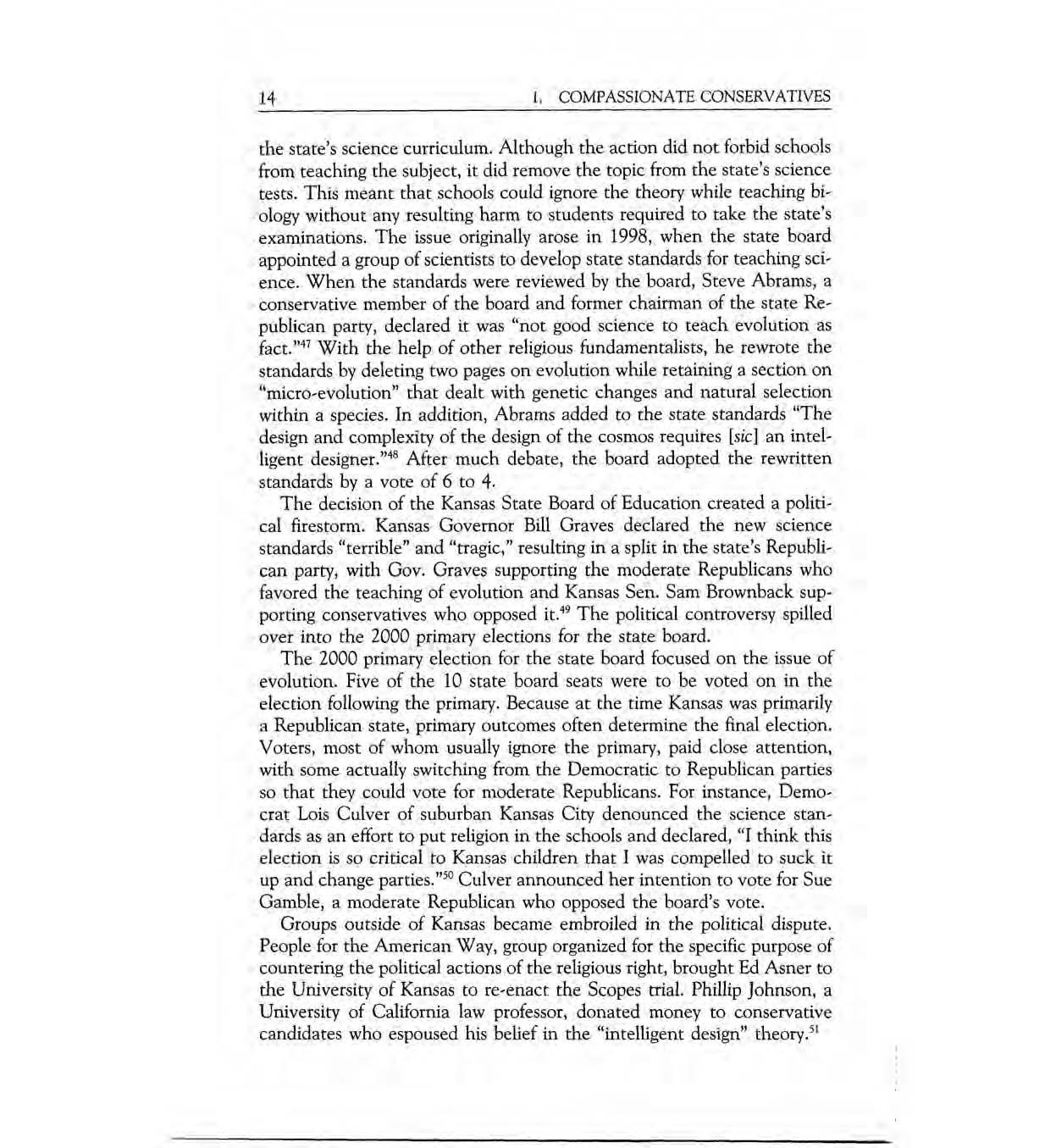
the state’s science curriculum. Although the action did not forbid schools from teaching the subject, it did remove the topic from the state’s science tests. This meant that schools could ignore the theory while teaching biology without any resulting harm to students required to take the state’s examinations. The issue originally arose in 1998, when the state board appointed a group of scientists to develop state standards for teaching science. When the standards were reviewed by the board, Steve Abrams, a conservative member of the board and former chairman of the state Republican party, declared it was “not good science to teach evolution as fact.”47With the help of other religious fundamentalists, he rewrote the standards by deleting two pages on evolution while retaining a section on “micro-evolution” that dealt with genetic changes and natural selection within a species. In addition, Abrams added to the state standards “The design and complexity of the design of the cosmos requires [sic] an intelligent designer.”48After much debate, the board adopted the rewritten standards by a vote of 6 to 4.
The decision of the Kansas State Board of Education created a political firestorm. Kansas Governor Bill Graves declared the new science standards “terrible” and “tragic,”resulting in a split in the state’s Republican party, with Gov. Graves supporting the moderate Republicans who favored the teaching of evolution and Kansas Sen. Sam Brownback supporting conservatives who opposed it.49The political controversy spilled over into the 2000 primary elections for the state board.
The 2000 primary election for the state board focused on the issue of evolution. Five of the 10 state board seats were to be voted on in the election following the primary. Because at the time Kansas was primarily a Republican state, primary outcomes often determine the final election. Voters, most of whom usually ignore the primary, paid close attention, with some actually switching from the Democratic to Republican parties so that they could vote for moderate Republicans. For instance, Democrat Lois Culver of suburban Kansas City denounced the science standards as an effort to put religion in the schools and declared, “I think this election is so critical to Kansas children that I was compelled to suck it up and change par tie^."^' Culver announced her intention to votefor Sue Gamble, a moderate Republican who opposed the board’s vote.
Groups outside of Kansas became embroiled in the political dispute. People for the American Way, group organized for the specific purpose of countering the political actions of the religious right, brought Ed Asner to the University of Kansas to re-enact the Scopes trial. Phillip Johnson, a University of California lawprofessor, donated money to conservative candidates who espoused his belief in the “intelligent design”
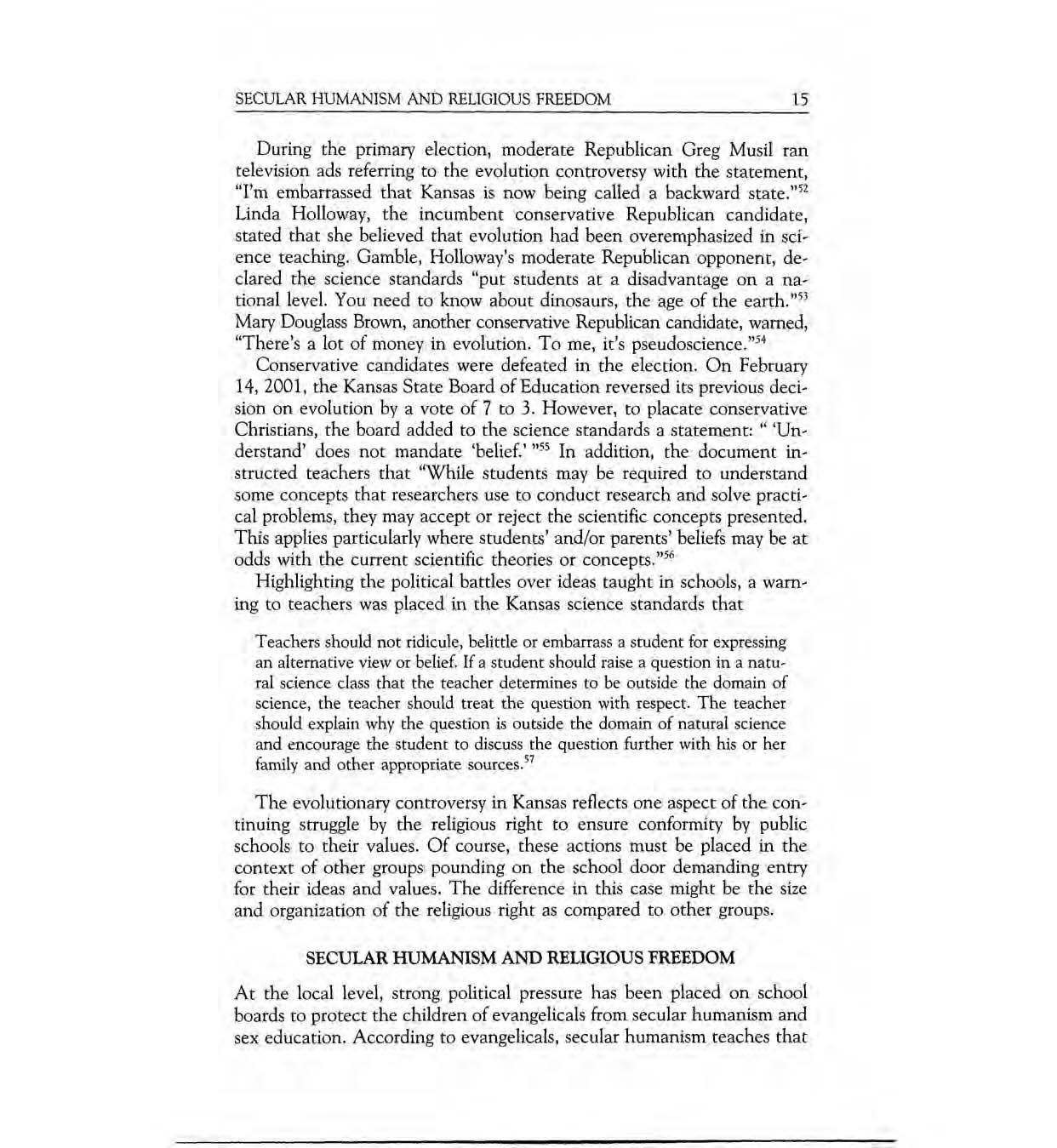
During the primary election,moderate Republican Greg Musil ran television ads referring to the evolution controversy with the statement, “I’m embarrassed that Kansas isnow being called a backward state.”52 Linda Holloway, theincumbentconservativeRepublicancandidate, stated that she believed that evolution had been overemphasized in science teaching. Gamble, Holloway’s moderate Republican opponent, declared the science standards “put students at a disadvantage on a national level. You need to know about dinosaurs, the age of the earth.”53 Mary Douglass Brown, another conservative Republican candidate, warned, “There’s a lot of money in evolution. To me, it’s pseudo~cience.”~~ Conservative candidates were defeated in the election. On February 14, 2001, the Kansas State Board of Education reversed its previous decision on evolution by a vote of 7 to 3. However, to placate conservative Christians, the board added to the science standards a statement: “ ‘Understand’ does notmandate ‘belief.’ ’’55 In addition,thedocumentinstructed teachers that “While students maybe required to understand some concepts that researchers use to conduct research and solve practical problems, they may accept or reject the scientific concepts presented. This applies particularly where students’ and/or parents’beliefs may be at odds with the current scientific theories or Highlighting the political battles over ideas taught in schools, a warning to teachers was placed in the Kansas science standards that
Teachers should not ridicule, belittle or embarrass a student for expressing an alternative view or belief.If a student should raise a question in a natural science class that the teacher determines to be outside the domain of science, the teacher should treat the question with respect. The teacher should explain why the question is outside the domain of natural science and encourage the student to discuss the question further with his or her family and other appropriate sources.57
The evolutionary controversy inKansas reflects one aspect of the continuing struggle by the religious right toensure conformity by public schools to their values. Of course, these actions must be placed in the context of other groups pounding on the school door demanding entry for their ideas and values. The difference in this case might be the size and organization of the religious right as compared to other groups.
SECULAR HUMANISMAND RELIGIOUS FREEDOM
At the local level, strong political pressure has been placed on school boards to protect the childrenof evangelicals from secular humanism and sex education. According to evangelicals, secular humanism teaches that
individuals can reason their way to moral decisions rather than rely on the Word of God. Evangelical Christians do not want children to use reasoning in solving moral dilemmas. Instead, they want strict obedience to the Word of God.
One of the first major court cases involving secular humanism began in 1983 in the schools of Hawkins County, Tennessee, when a local parent expressed concern about a new series of readers published by Holt, Rinehart & Winston. According to the complaint, the books were filled with “minorities, foreigners, environmentalism, women in nontraditional roles, and open-ended value judgments without clear right and wrong answer^."^'
The case attracted the attention of a wide variety of religious groups opposed to the teaching of secular humanism, such as Phyllis Schlafly’s Eagle Forum, the National Association of Christian Educators, Citizens for Excellence in Education, Concerned Women for America, Pat Robertson’s National Legal Foundation, and the American Family Association. In opposition to these groups was the liberal organization People for the American Way.
Criticism of the textbooks included a wide range of topics under the banner of secular humanism. Believing that unregulated capitalism was God’s will, critics objected to suggestions of environmentalism because it led to government intervention in the economy. Protestors objected to teaching religious tolerance because it suggested that other religions were equal in value to Christianity. The teaching of international cooperation, evangelicals argued, could lead to world government, which would mean the reign of the antichrist. They also objected to stories that suggested humane treatment of animals and vegetarianism because God created animals for human use and exploitation. Evangelicals particularly objected to any story suggesting that hunting was wrong. Also, they felt that stories suggesting the depletion of resources and the extinction of species were denying God’s promise to meet all human needs. Men and women portrayed in nontraditional roles would, according to protestors, destroy the traditional Christian family in which wives remained at home raising their children. For this reason, they opposed anything that smacked of feminism.59
After 4 years of litigation, the Sixth Circuit Court of Appeals ruled that public schools did not have to accommodate religious objections to the Holt, Rinehart & Winston readers. A previous lower court ruling suggested that religious objections to the books could be accommodated by assigning different texts or by teaching reading at home. The final ruling enhanced the power of school boards by requiring children attending public schools to read the books selected by school officials.“
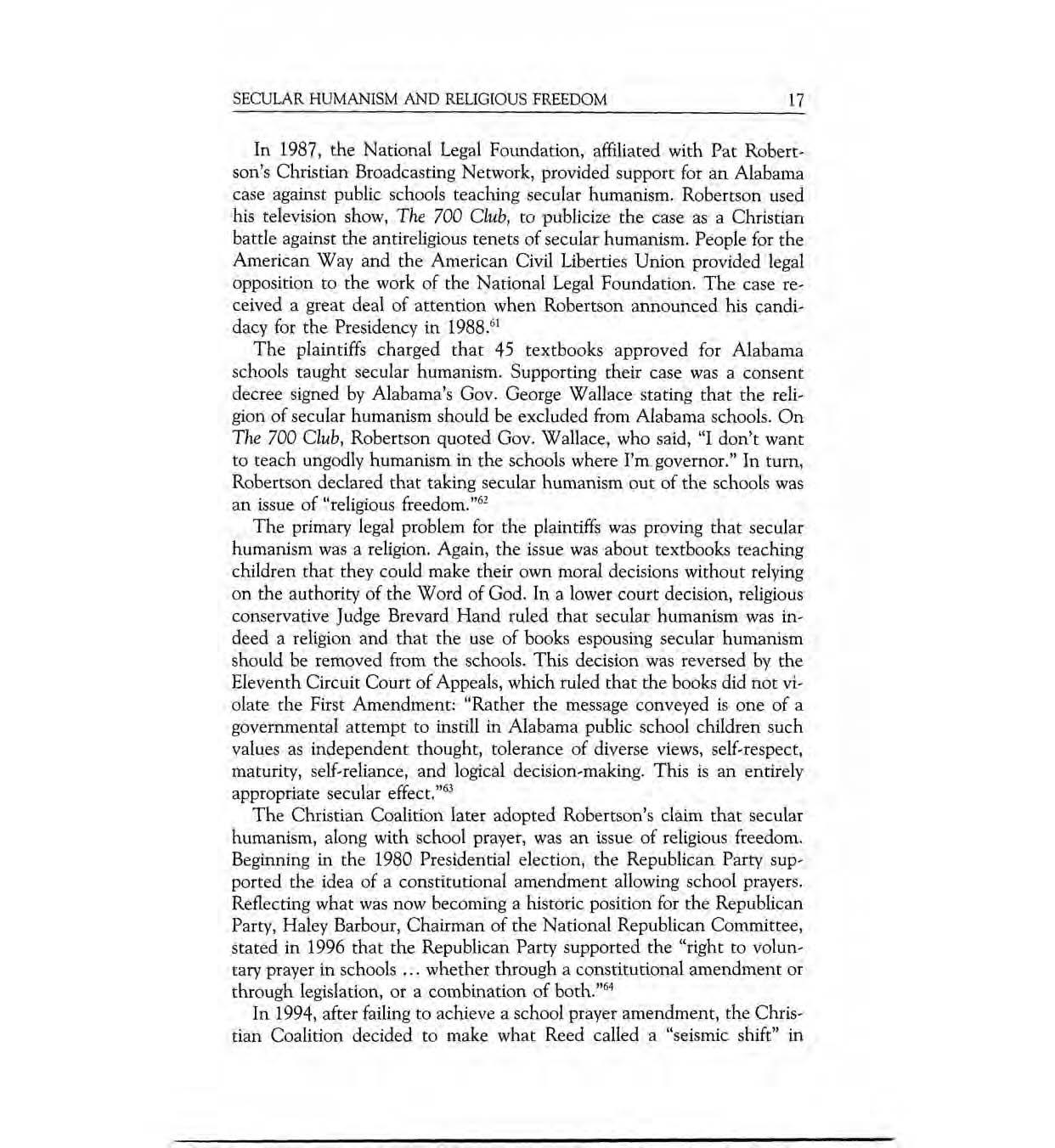
In 1987, the National Legal Foundation, affiliated with Pat Robertson’s Christian Broadcasting Network, provided support for an Alabama case against public schools teaching secular humanism. Robertson used his television show, The 700 Club, to publicize the case as a Christian battle against the antireligious tenets of secular humanism. People for the American Way and the American Civil Liberties Union provided legal opposition to the work of the National Legal Foundation. The case received a great deal of attention when Robertson announced his candidacy for the Presidency in 1988.(j1
The plaintiffs charged that 45 textbooksapproved for Alabama schools taught secular humanism. Supporting their case was a consent decree signed by Alabama’s Gov. George Wallace stating that the religion of secular humanism should be excluded from Alabama schools. On The 700 Club, Robertson quoted Gov. Wallace, who said, “I don’t want to teach ungodly humanism in the schools where I’m governor.” In turn, Robertson declared that taking secular humanism out of the schools was an issue of “religious freedom.”62
The primary legal problem for the plaintiffs was proving that secular humanism was a religion. Again, the issue was about textbooks teaching children that they could make their own moral decisions without relying on the authority of the Word of God. In a lower court decision, religious conservative Judge Brevard Hand ruled that secular humanism was indeed a religion and that the use of books espousing secular humanism should be removed from the schools. This decision was reversed by the Eleventh Circuit Court of Appeals, which ruled that the books did not violate the First Amendment: “Rather the message conveyed is one of a governmental attempt to instill in Alabama public school children such values as independent thought, tolerance of diverse views, self-respect, maturity, self-reliance, and logical decision-making. This is an entirely appropriate secular
The Christian Coalition later adopted Robertson’s claim that secular humanism, along with school prayer, was an issue of religious freedom. Beginning in the 1980 Presidential election, the Republican Party supported the idea of a constitutional amendment allowing school prayers. Reflecting what was now becoming a historic position for the Republican Party, Haley Barbour, Chairman of the National Republican Committee, stated in 1996 that the Republican Party supported the “right to voluntary prayer in schools ... whether through a constitutional amendmentor through legislation, or a combination of both.”64
In 1994, after failing to achieve a school prayer amendment, the Christian Coalition decided to make what Reed called a “seismicshift’’ in
strategy. Rather than campaigning for school prayer, the decision was made to adopt Robertson’s language and support an amendment for religious freedom. Reed argued that an emphasis on religious freedom as opposed to the narrower issue of school prayer would appeal to a broader religious audience. The religious freedom amendment would guarantee the right of religious expression to all people in all public settings.65
In addition, the Christian Coalition believes that a religious-freedom amendment would protect the rights of students to express their religious beliefs in the classroom. For instance, a student would have the right to support creationism over evolutionary theory in science classes.
In supporting the religious-freedom amendment Reed described the case of a Tennessee high school student, Brittney Settle, who was failed for turning in an essay on the life of Jesus Christ. Without citing the details of the case, Reed claimed that a federal court upheld the right of the school to flunk the student for her religious beliefs. In reaction to the case, Reed stated, “A religious freedom amendment would protect her, along with unbelieving students who are nervous about being compelled to participate in mandatory religious exercises in public schools.”66
Reps. Newt Gingrich and Dick Armey promised the Christian Coalition that for its support of Republican candidates they would introduce a proposal for inclusion of religious freedom inthe First Amendment. When the House Judiciary Committee held hearings in July 1996 on the proposed changes, members of Americans United for Separation of Church and State and otherreligious groups held a protest in front of the Supreme Court. The proposed changes to the First Amendment would “protect religious freedom, including the right of students in public schools to pray without government sponsorship or compulsion.” In addition, the changes would prohibit state and federal governments from denying anyone “equal access to a benefit, or otherwise discriminate against any person, on account of religious belief, expression, or exercise.”67
During the hearings, the head of the Judiciary Committee, Republican Rep. Henry Hyde, complained that public school teachers often discriminated against Christians by denying reports and essays on Jesus Christ. “Public school teachers, who accept reports on witches,” Hyde explained, “forbid students from writing reports on Jesus. This is madness.”68
One cynical critic, David Ramage, Jr., president emeritus of the McCormick Theological Seminary, accused theChristianCoalition of wanting to rush the amendments through the House of Representatives so that House members’ positions could be included in their fall voting guide. Voting “no” on the religious-freedom changes, Ramage suggested, would be listed in the Christian Coalition’s voter guide as “a vote against religious freedom” or a “vote against
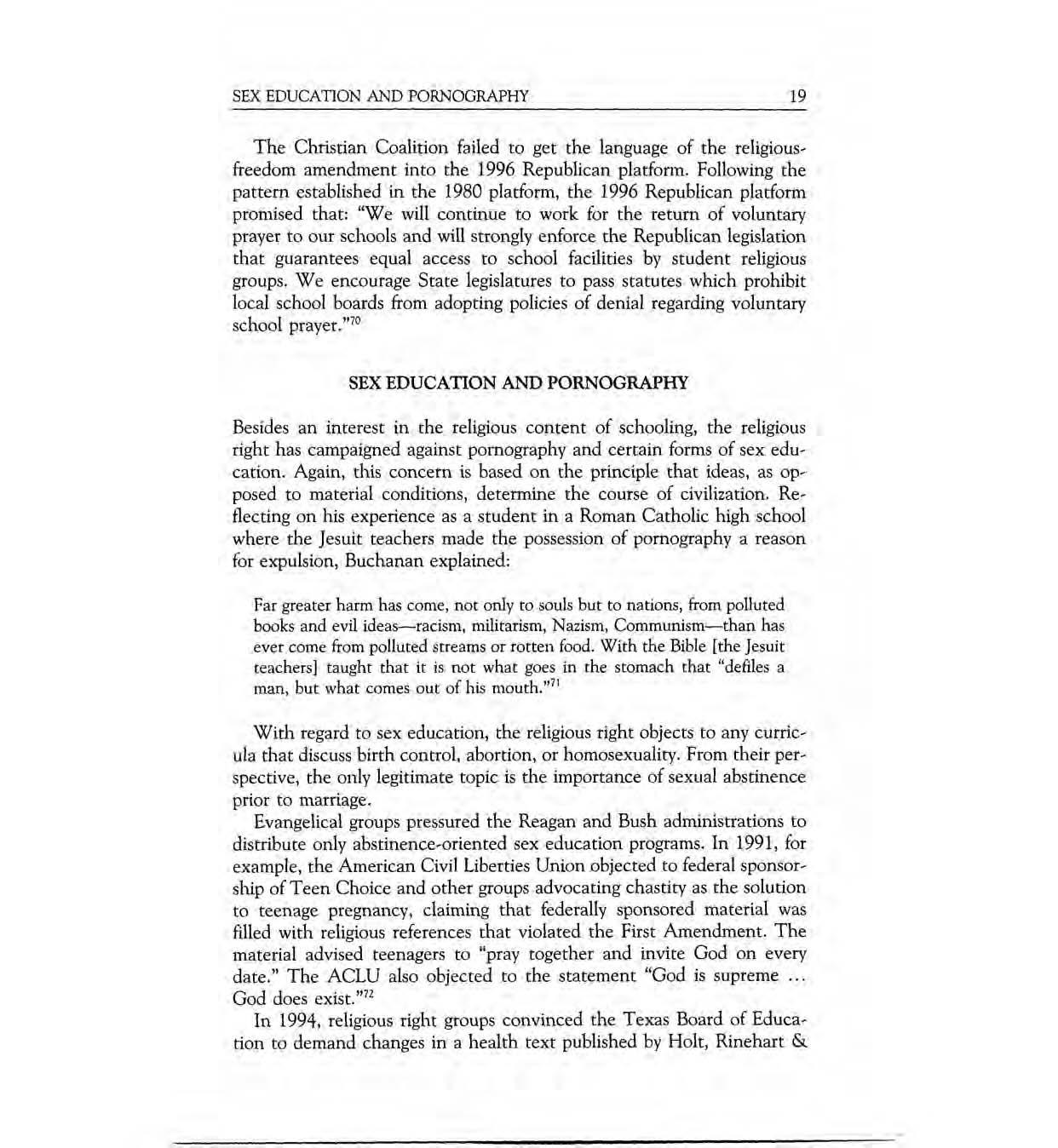
The Christian Coalition failed to get the language of the religiousfreedom amendment into the 1996 Republican platform. Following the pattern established in the 1980 platform, the 1996 Republican platform promised that: “We will continue to workfor the return of voluntary prayer to our schools and will strongly enforce the Republican legislation that guarantees equal access to school facilities by student religious groups. We encourage State legislatures to pass statutes which prohibit local school boards from adopting policies of denial regarding voluntary school prayer.”70
SEX EDUCATION AND PORNOGRAPHY
Besides an interest in the religious content of schooling, the religious right has campaigned against pornography and certain forms of sex education. Again, this concern is based on the principle that ideas, as opposed to material conditions, determine the course of civilization. Reflecting on his experience as a student in a Roman Catholic high school where the Jesuit teachers made the possession of pornography a reason for expulsion, Buchanan explained:
Far greater harm has come,not only to souls but to nations, from polluted books and evil ideas-racism, militarism, Nazism, Communism-than has ever come from polluted streams orrotten food. With the Bible [the Jesuit teachers] taught that it is not what goes in the stomach that “defiles a man, but what comes out of his mouth.”71
With regard to sex education, the religious right objects to any curricula that discuss birth control, abortion, or homosexuality. From their perspective, the only legitimate topic is the importance of sexual abstinence prior to marriage.
Evangelical groups pressured the Reagan and Bush administrations to distribute only abstinence-oriented sex education programs. In 1991, for example, the American Civil Liberties Union objected to federal sponsorship of Teen Choice and other groups advocating chastity as the solution to teenage pregnancy, claiming that federally sponsored material was filled with religious references that violated the First Amendment. The material advised teenagers to “pray togetherandinvite God on every date.” The ACLU also objected to the statement “God is supreme ... God does exist.”72
In 1994, religious right groups convinced the Texas Board of Education to demand changes in a health text published by Holt, Rinehart &
Winston.Monte Hasie, a member of theTexas Board of Education, claimed the books “were promoting homosexuality as an acceptable alternative life style and promoting sex as being O.K. if you use a condom. We weregoing to put Playboy and Penthouse out of bu~iness.”~~After months of hearing testimony from family-planning, antiabortion, gay advocacy, fundamentalist Christian and other groups, the board mandated that the health book and four others under consideration delete toll-free numbers for gay, lesbian, and teenage suicide groups; illustrations of examinations for testicular cancer; and sections on homosexuality. They also asked for inclusion of descriptions of Texas laws against sodomy.
The Christian Coalition’s influence on the 1996 Republican platform is clearly evident in its long section on sex education, which emphasizes the importance of sexual abstinence prior to marriage. “We support,” the platform stated, “educational initiatives to promote chastity until marriage as the expected standard of behavior.”74In addition, the platform enunciated its opposition to “school-based clinics, which provide referrals, counseling, and related services for contraception and The religious right condemns any instruction or positive statements about homosexuality. For the Christian Coalition and other members of the religious right, homosexuality should be publicly condemned. Buchanan argued that gay men should be blamed for bringing about the AIDS plague. In fact, the Christian Coalition’s first membership drive in 1989 focused on theNational Endowment for the Arts sponsorship of the homoerotic photographs of Robert Mappleth~rpe.~~
Evident in the 1996 Republican platform are objections to gay and lesbianrights. The platformpraised the recently passed Republicansponsored Defense of Marriage Act. In the words of the platform, this legislation “defines ‘marriage’ for purposes of federal law as the legal union of one man and one woman and prevents federal judges and bureaucrats from forcing states to recognize other living arrangements as ‘marriages.’ ””
In 1995, the Christian Coalition placed strong political pressure on Congress to censure pornography on the World Wide Web and television. In its effort to remove pornography or, as it is called, cyberporn, from the World Wide Web, the Christian Coalition sought the aid of Democrats after Massachusetts Democratic Rep. Edward Markey introduced a bill requiring television manufacturers to install “v-chips” to allow parents to block programs with too much violen~e.~~
Working with a group of Democrats and Republicans, the Christian Coalition claimed a major responsibility for the writing of the 1995 Telecommunications Act requiring censorship of cyberporn and v-chips. Reed
believes that passage of the telecommunications legislation moved the Christian Coalition from simple criticism of legislative action to the exercise of legislativepower. Reed and other coalition members sat down with members of Congress and worked out the details of the telecommunications legislation.
The work onthe telecommunications bill demonstrated thatthe Christian Coalition could influence both political parties. Reed argues that the relationship between evangelical Christians and the Republican Party is simply strategic. “The two are not one and the same,” he stated. “Indeed, the partnership between the profamily movement and the GOP is less a romance than a shotgun wedding.”79
MULTICULTURAL EDUCATION
Another major area of concern for the religious right is multicultural curricula. Evangelical Christians donot believe, as mentioned before, in teaching tolerance of other religions. For evangelicals, Christianity is the only true religion. Inaddition, the religious right believes thatthe Judeo-Christian foundation of Americanculture makes it superior to other cultures. Therefore, instruction should emphasize the inculcation of Judeo-Christian culture and not tolerance for other cultures.
In 1986, William Bennett made a name for himself in academic circles when he launched a public attack against the Stanford University faculty for replacing a freshman undergraduate course entitled “Western Culture,” inwhich students read 15 works in Western philosophy and literature, with a course entitled “Cultures, Ideas, and Values,’’in which readings would include works by “women, minorities, and persons of color.”s@ Bennett argued that students should be required to study Western culture because it provides the framework for American government and culture. In addition, he stated, “Probably most difficult for the critics of Western culture to acknowledge is that ‘the West is good’.” Western culture, according to Bennett, has “set the moral, political, economic, and social standards for the rest of the world.’’81
In 1994, issues of religion, sex, and multiculturalism came together in a bitter struggle among the governor of California, the state legislature, and educators over a proposed statewide test for grades K-12. The stornl over the test, originally called the Ca&ornia Learning Assessment System test and later the California Comprehensive Assessment System, erupted when author Alice Walker and the People for the American Way objected to state education officials removing from the test two of Walker’s stories.
One story, “Roselily,”was removed because of objections by the Traditional Values Coalition,a religious right organization. The story dealt with a Christian woman in rural Mississippi marrying a Muslim, and it was considered antireligious. Beverly Sheldon, research director for the Traditional Values Coalition, argued that the test would influence the religious values of students.
The other story by Walker was removed because a member of the state board of education considered it hostile to meat eating. As mentioned previously in the discussion of the Tennessee case, evangelicals believe God put animals on earth to be eaten and exploited by humans.
The People for the American Way objected to the removal of the stories because it sent “a chilling message across the country of the threat to educational freedom and constitutional rights posed by extremist pressure groups.”sz
By May of 1994, hundreds of people were turning out for school board meetings throughout California to support or protest the test. Some of the protests were about a rumored question depicting a barber contemplating the slitting of a customer’s throat. A Los Angeles school board member, Sue Stokka, objected on the basis that the test did not emphasize basic skills. A temporary restraining order against giving the test in the San Bernadino school district was issued by a superior court judge after a suit was filed by the conservative Rutherford Institute. The school board in the Antelope Valley Union High School district voted not to give the test.
By September of 1994 the test was a major political issue. Gov. Pete Wilson, who was running for re-election in November, threatened to veto a reauthorization of the testing program. A new objection to the test program was raised when a study found thatmen, Latinos, and Asian Americans were underrepresented among the groups that developed the test questions. A new legislative bill called for the exclusion of all questions related to personal beliefs regarding family life, gender, and religion.83
The religious right’s stance against multiculturalism is reflected in the 1996 Republican platform’s call for an emphasis in schools on teaching about Western civilization and its pledge to make English the official language of the United States. The platform vowed to create an education consumer’s warranty which, among other things, would guarantee that all American children would “learn the nation’s history and democratic Values and study the classics of Western ci~ilization.”~~ In addition, the platform proposed that “To reinforce our American heritage ... [states and local school boards require] our public schools to dedicate one full day
each yearsolely to studying the Declaration of Independence and the Con~titution.”’~With regard to the language issue, the platform clearly stated: “We support the official recognition of English as the nation’s common language.”86
Reed recognized that many Republicans and Democrats do not share the Christian Coalition’s religious interest in school choice, secular humanism, sex education, and multiculturalism. However, many Republicans recognize the importance of the religious right’s voting power. Althoughhesupported Republicans inthe1994 Congressional contest, Reed was disappointed that many concerns of the religious right were not included in the Contract With America, a political statement drafted by right-wing Republicans. But, thinking like apracticalpolitician, Reed hoped that “success on the Contract with America ... would build the political capital necessary to gain passage of other legislative initiatives dealing with abortion and school ~hoice.”’~
LIBERAL DOMINATION OF EDUCATION AND CULTURE
There is a strong populist rhetoric running through the statements of the religious right. Even New Democrats claim that they want to reduce the power of the federal government and return the control of public institutions to the people. Arguments for school choice emphasize breaking the stranglehold of an educational bureaucracy andreturning power over schooling to parents. A great deal of the rhetoric is antigovernment and filled with complaints that government agencies and bureaucrats represent a third class that for its own benefit has seized power from the people.
This rhetoric was evident in the acceptance speech of Vice Presidential candidateJack Kemp, atthe 1996 Republican convention. Kemp charged that Democratic opponents were elitists who “don’t have faithin the people. They have faith in government.”88 Although Kemp, in his speech, was primarily concerned with economics, he was playing on the supposed dislike of the general public for government policies created by bureaucratic experts and then forced on an unsuspecting populace. Many in the religious right believe the liberal elite is composed of both cultural and government leaders. William Bennett argued that the cultural war is between the beliefs held by most citizens and “the beliefs of a liberal elite that today dominates many of our institutions andwho therefore exert influence on Americanlife and culture.”’? This liberal elite, according to Bennett, inhabits universities, the literary and artistic worlds,
CONCLUSION
As Michael Lind wondered, is the culture war a smoke screen for growing economic inequalities? Are northern and southern White workers simply blaming cultural and racial changes for a decline in real income? Should northern and southern White workers be focusing their attention on the redistribution of wealth as opposed to cultural issues? Whether the culture waris a smoke screen for the increasing economic inequalities in U.S. society or a result of a growing sense of alienation and disadvantage among White workers, the result is a sharp political debateabout U.S. schools. School choice and privatization could cause major structural changes in education. Issues of evolution, secular humanism, sex education, multiculturalism, and affirmative action will continue to contribute to political divisiveness.
NOTES
Molly Ivins and Lou Dubose, Shrub: The Short But Happy Political Life of George W. Bush (New York: Random House, 2000), 60-63.
“Off to a Quick Start,” Education WeekontheWeb, 14February2001.Available: www.edweek.org
Joetta L. Sack, “New Secretary Has a Playbook for Motivating Students,” Education Week on the Web, 14 February 2001. Available: www.edweek.org
Kathleen Manzo, “Drilling ~n Texas,” Education WeekontheWeb, 10 June 1998, 1. Available: www.edweek.org
Sack, “New Secretary.” Ibid.
“Educational Policy Statement of Bush Campaign,”retrieved fromhttp://www. georgebush.com, 24 August 2000.
MarvinOlasky, Renewing AmericanCompassion (Washington, DC: Regnery, 1997), 41-42.
Ibid., 36.
Ibid., 29-30.
Ibid., 28.
George W. Bush, Comment on the front cover of Myron Magnet, The Dream and the Nightmare:TheSixties’Legacytothe Underchss(SanFrancisco: Encounter Books, 2000).
Magnet, The Dream, 20. Ibid., 24.
Patrick J. Buchanan, RightFromtheBeginning (Washington, DC: Regnery Gateway, 1990), 14.
Michael Lind, Up From Conservatism: Why the Right Is Wrong for America (New York: The Free Press, 1996), 154.
Ibid., 161.
Buchanan, Right From the Beginning, 6. Emphasis in quote is Buchanan’s.
William J. Bennett, The De-Valuing of America: The Fight for Our Culture and Ozu Children (New York: Simon & Schuster, 1992), 36.
Joel Spring, The American School, 5th ed. (New York: McGraw-Hill, 2001), 58-133.
Bennett, The De-Valuing of America, 206.
Ralph Reed, Active Faith: How Christians Are Changing the Soul of Amerzcan Politics (New York: Free Press, 1996), 9.
This message is given on the Christian Coalition’s Web site, http://cc.org/about.html.
See JacobWeisberg, In Defense of Government: The Fall and Rise of Public Trztst (New York: Scribner’s, 1996), andMichael Tomasky, Left for Dead: The Life, Death and Possible Resurrection ofProgressivePolitics in America (New York: Free Press, 1996).
See Joel Spring, The American School: 1642-1 993 (New York: McGraw-Hill, 1994),
Reed, Active Faith, 105.
Jacob Weisberg, “Fear and Self-Loathing,” New York (19 August 1996), 36. Ibid., p. 36.
Reed, Active Faith, 4, 11.
Buchanan, Right From the Beginning, 6.
Reed, Active Faith, 109-1 11.
Reed, Active Faith, 111.
1996 Republican Party Platfornl as released over the Republican World Wide Web site on 13 August 1996, p. 15.
Alan Elmer, “Evangelicals Assert Control of Republican Party,” Compuserve Executive News Service, Reuters Ltd., 7 August 1996, 1.
Ibid.
1996 Republican Platform, 21-23.
Ibid., 21.
Ibid.
Reed, Active Faith, 188-235. Christian Coalition, http://cc.org.
Ibid.
Ibid.
[bid.
Ibid.
Pam Belluck, “Kansas Votes to Delete Evolution From State’s Science Curriculum,” New York Times on the Web, 12 August 1999. Available: www.nytinles.com
[bid.
[bid.
[bid.
Pam Belluck, “Board Decision on Evolution Roils an Election in Kansas,” Neuj York Times on the Web, 29 July 00.Available: www.nytimes.com 406-407, 412-414.
Ibid.
John W. Fountain, “Kansas Puts EvolutionBack Into Public Schools,” New York Timesonthe VC’eb, 15 February 2001. Available: www.nytin1es.com
Ibid.
Ibid.
Joan Delfattore, Wlat Jolmny Shouldn’tRead:TextbookCensorshipinAmerica (New Haven, CT: YaleUniversityPress, 1992), 14.
Ibid., 36-60.
Ihid., 61-75.
Ibid., 76-79.
Ibid., SI.
Ibid., 87.
Haley Barbour, Agenda for America: A Republican Direction for the Future (Washington, DC: Regnery, 1996), 159.
Reed, Active Faith, 117-1 18.
Ibid., 118.
See Eric Schmitt, “Church LeadersSplit on Plan for School Prayer Amendment,” NewYork Times, 24 July 1995, A16, and Jim Luther, “School Prayer,” Compuserve Executive News Service, Associated Press, 22 July 1996, 1. Schmitt, “Church Leaders,” 16. Ihid.
1996 Republican Platform, 21.
Buchanan, RightFromtheBeginning, 339; Reed, ActzveFazth, 131.
Laurie Asseso, “Teen Chastity,” Compuserve Executive News Service, No. 2120, 17 February 1991.
Sam Dillon,“PublisherPulls a Textbook in Furor on Sexual Content,” New York Times,17 March 1994, B10.
1996 Republican Platform, 21. Ibid.
Buchanan, RightFromtheBeginning, 339; Reed, Active Faith, 131. Ibid., 20.
Reed, Active Faith, 229-23 1.
Ibid,, 234.
Bennett, The De-Valzcing of America, 170. Ibid.
Karen Diegmuller, ‘‘Removal of LiteraryWorks From California Test Stirs Flap,” EducationWeek, 9 March 1994, 11.
Karen Diegmuller, “Model Exam in California Is Target of New Attacks,” Education Week, 4 May 1994, 1, 12.
1996 Republican Platform, 2 1.
85. Ibid.
86. Ibid., 17.
87. Reed, ActiveFaith,185.
88. Adam Nagourney, “Kemp Gives Early Look at Strategy,”New York Times, 15 August
89. Bennett, The De-Valuing of America, 26. 1996, A24.
and Community Initiatives. Influence on economic policy was ensured by the institute’s former Senior Fellow Lawrence Lindsay acting as Chief Economic Advisor to Bush and the appointment of the Institute’s David Frum as Special Assistant to the President for Economic Speech Writing. While at the Institute, Lindsay wrote the book that influenced Bush’s tax policies: The Growth Experiment: How the New Tax Policy Is Transforming the U.S. Economy. The institute’s influence on civil rights issues was assured by the appointment of Senior Fellow Abigail Thernstrom to the U.S. Commission on Civil Rights. Also, of course, the institute cited Senior Fellow Myron Magnet’s book The Dream and the Nightmare ... [as] ‘The book that helped shape Bush’s message’.”2
The Manhattan Institute’s influence on national educational policies involves an amalgamation of politics and think tank intellectuals. The Manhattan Institute is a nonprofit organization that funds scholarly work for the purpose of influencing public policy. “The Manhattan Institute,” the opening line posted on its website declares, “has been an important force in shaping American political ~ulture.”~This isfollowed by the statement “We have supported and publicized research on our era’s most challenging public policyissues: taxes, welfare, crime, the legal system, urban life, race, education, and many other topic~.”~
Even more revealing of its open use of scholarship to promote certain political and educational causes is the statement accompanying its plea for donations. Written by the institute’s trustee,WalterWriston,the contribution form contends that “The Institute’s intellectual capital far exceeds its financial capital, making it the most cost-effective organization of its kind. Although the impact of our ideas dwarfs our financial resources, we still need the latter. There is not a better bargain to be had.”5 At the bottom of the form the contributor is asked if he or she wants to receivee-mailupdates on‘(Education Reform,”“Welfare Reform,’’ ‘(CrimeReduction,” “Faith-Based Initiatives,’’ “Race and Ethnicity Initiatives,” and “Legal Reform.”‘
Educational policy was Bush’s topic when he spoke at the Manhattan Institute during the 2000 primary campaign. At the institute, Bush was warmly greeted as“my homeboy” by former congressman Rev, Floyd Flake.7 In this tangled web of connections, Flake had, just before introducing Bush, accepted the headship of the charter school division of the Edison Schools Inc., the largest for-profit school-management company in the country. Flake is listed on the “Education Reform” section of the institute’s Web site along with former U.S. Department of Education Assistant Secretaries Chester E. Finn, Jr., and Diane Ravitch as being “at the forefront of today’s thinking about how our children’s educational

program would seek to find out if vouchers are an effective means of improving school conditions. However, the institute’s program statements indicate a belief that vouchers are the solution: “One of the most important areas of research for our experts will be the need for school vouchers ... Vouchers ... would both improve educational Performance and give the existingpublicschoolbureaucracy an incentivetomakedramatic changes in their schools in order to keep parents ~atisfied.”’~
Therefore, the goal of the institute’s support of research is not toprove whethervouchersare effective buttocreate argumentssupporting voucher plans. Objective research is replaced by political polemics. This is most evident in the institute’s efforts to effect public opinion through marketing its educational experts to the media. Using its contacts in the media, the Manhattan Institute ensures that its paid scholars will be contacted for their opinions on educational policies. This results in the frequent appearance of their experts’ names in newspaper stories. The institute proudly keeps track of its media influence and lists it on its Web site under the categories of “National Media Attention” and“Press Releases.” Examples of the effectiveness of these efforts can be found in daily newspapers. For instance, when the New York Times reported on threatened teachers’ strikes, there appeared the following comment: “ ‘Some of the reforms that bear on teachers are beginning to gain some traction on the ground, and teachers’ organizations don’t like that at all,’ said Chester E. Finn Jr., an education expert at the Manhattan Institute, a conservative research ~rganization.”’~ The ManhattanInstitute is opposed to the work of teachers’ unions. When Massachusetts students protested state testing, the New York Times reported, “ ‘What we are asking for is knowledge that any student who wants a high school diploma worth the paper it’s written on should have,’ saidMs. Thernstrom, a senior fellow at the Manhattan Institute, a conservative research group. ‘All other measures are subjective.’ ”15 Along with George W. Bush, the institute supports statewide testing of students. When Donald G. and Doris Fisher, owners of The Gap clothing chain, announced they were providing $15 million in seed money to nationally franchise KIPP charter schools, the New York Times reported, “ ‘We’ve got brand-names for everything else,’ observed Chester E. FinnJr., an education analyst at the Manhattan Institute. ‘Now we have Comer schools and Hirsch schools, and we’regoing to have KIPP schools and Edison schools-You’re going to be able to move into a new city and say, “Show me the local Hirsch school.” That’s not a bad idea for a modern mobilesociety.’ ”16 The institute supports both charter schools and privatization of public schools,

